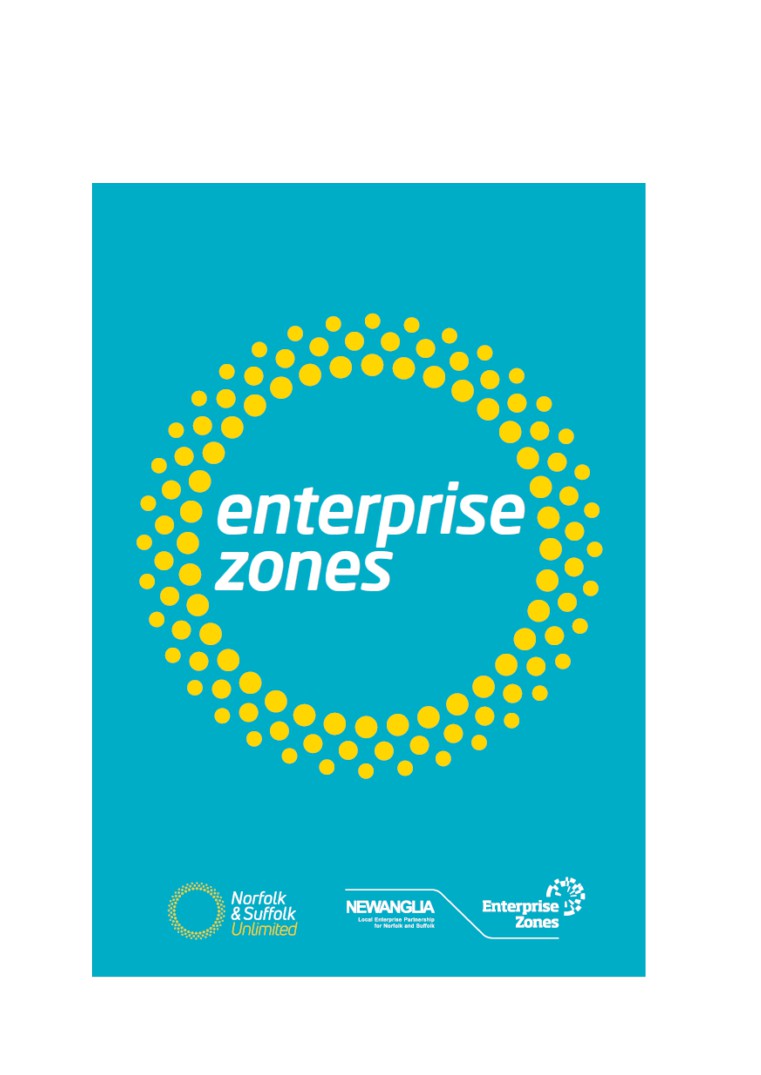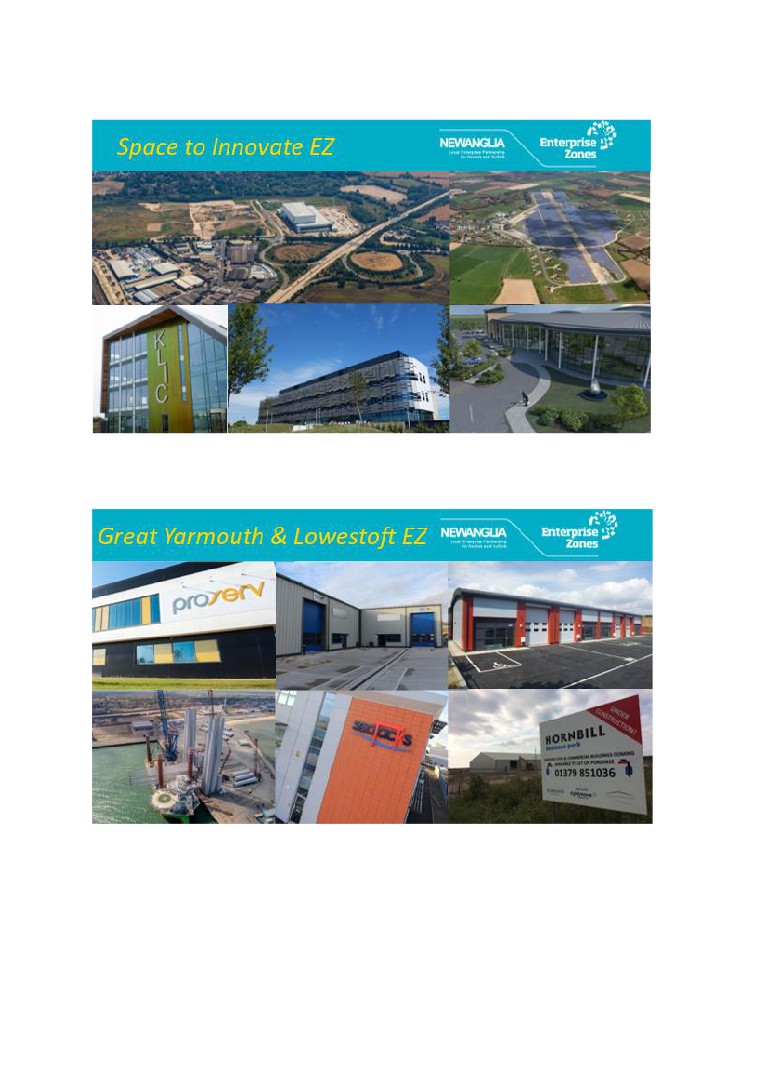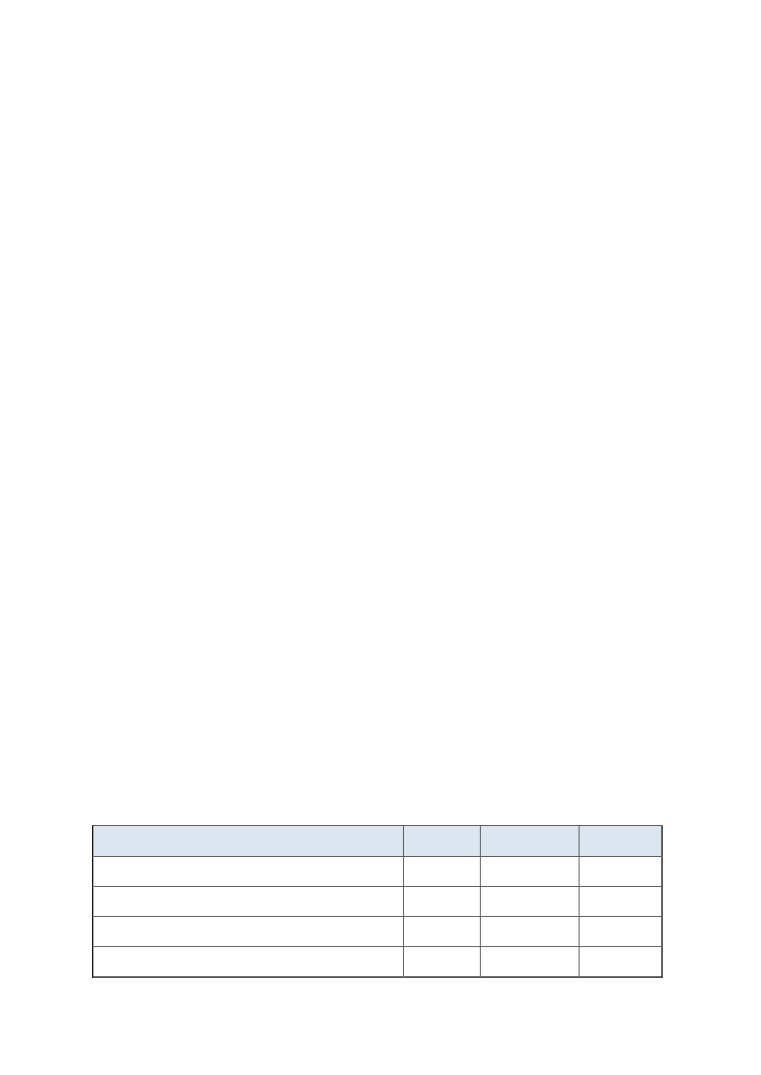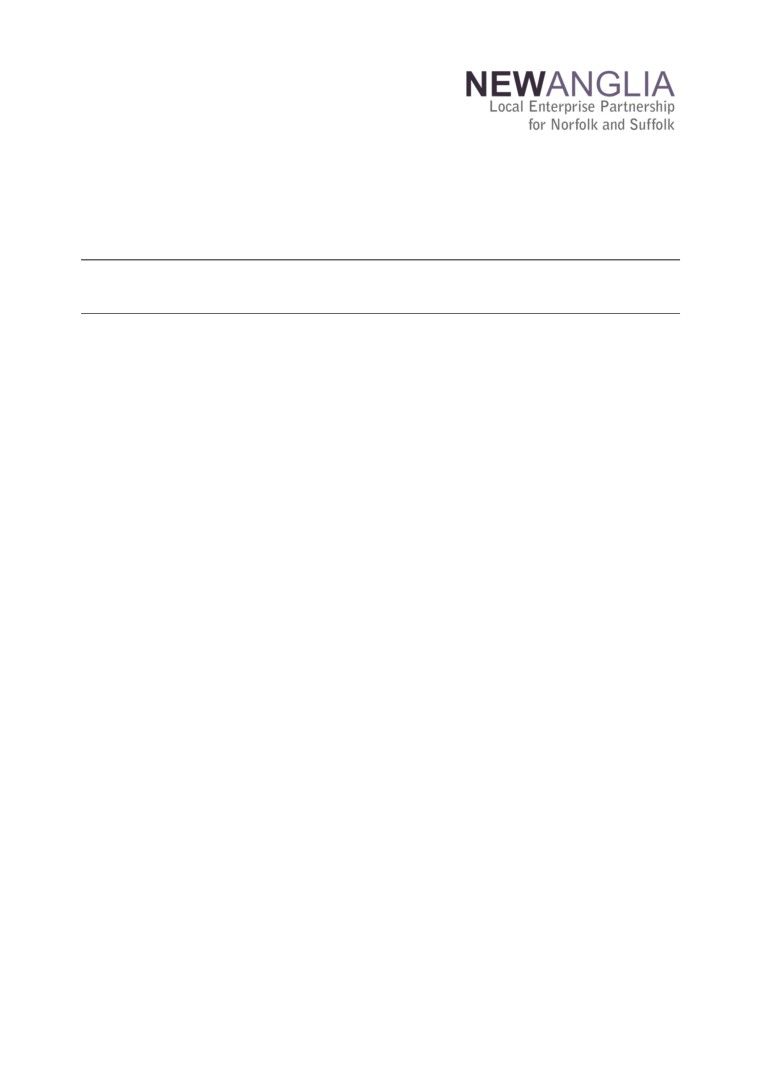New Anglia Local Enterprise Partnership Board Meeting
Wednesday 31st March 2021
10.00 - 12.30pm
Via MS Teams
Agenda
No.
Item
1.
Welcome from the Chair
2.
Presentation from Peter Brady - Innovation Labs, Stowmarket
3.
Apologies
4.
Declarations of Interest
5.
Actions / Minutes from the last meeting
Strategic
6.
Industry Council for Digital Tech Progress Report
Update
7.
Norfolk and Suffolk Enterprise Zones: Strategic Plan 2021-26
For Approval
Operational
BREAK - 15 Mins
8.
Future Role of LEPs
Update
9.
Large Company Grant Scheme Application - Confidential
For Approval
10.
Getting Building Fund - Suffolk Broadband Scheme - Confidential
For Approval
11
LEP Delivery Plan 2021/22
For Approval
12.
LEP Operating Budget 2021/22 - Confidential
For Approval
13.
New Anglia LEP Governance
For Approval
14.
Chief Executive’s Report - including confidential items
Update
15.
March Programme Performance Reports
Update
16.
Board Forward Plan
Update
17.
Any Other Business
18.
Chief Executive’s Pay Award - Confidential
For Approval
1
Confidential
New Anglia Board Meeting Minutes (Unconfirmed)
24th February 2021
Present:
Kathy Atkinson (KA)
Kettle Foods
Sam Chapman-Allen (SC)
Breckland Council
Claire Cullens (CC)
Norfolk Community Foundation
David Ellesmere (DE)
Ipswich Borough Council
C-J Green (CJG)
Brave Goose
John Griffiths (JG)
West Suffolk Council
Matthew Hicks (MH)
Suffolk County Council
Pete Joyner (PJ)
Shorthose Russell
Dominic Keen (DK)
Britbots
Helen Langton (HL)
University of Suffolk
Steve Oliver (SO)
MLM Group
Corrienne Peasgood (CP)
Norwich City College
Andrew Proctor (AP)
Norfolk County Council
Johnathan Reynolds (JR)
Opergy
Sandy Ruddock (SR)
Scarlett & Mustard
Alan Waters (AW)
Norwich City Council
Tim Whitley (TW)
BT
Attendees
Mohammad Dastbaz (MD) University of Suffolk - For Item 2
Shan Lloyd (SL)
BEIS
Mark Ash (MA)
Suffolk County Council
Vince Muspratt (VM)
Norfolk County Council
Ellen Goodwin (ET)
New Anglia LEP - For Item 10
Julian Munson (JM)
New Anglia LEP - For Item 6
Chris Starkie (CS)
New Anglia LEP
Rosanne Wijnberg (RW)
New Anglia LEP
Helen Wilton (HW)
New Anglia LEP
1
Actions from the meeting: (24.2.21)
Confidential Items
1
Welcome from the Chair
CJ Green (CJG) welcomed everyone to the meeting and noted the challenges ahead following the
announcement of the roadmap out of lockdown.
2
Presentation from Professor Helen Langton and Professor Mohammad Dastbaz
CJG welcomed Professor Mohammad Dastbaz (MD) to the meeting and invited him and Professor
Helen Langton (HL) to present the board with an overview of the 10 year plan and vision for the
University of Suffolk.
HL provided details of the increases in student numbers and highlighted high level of mature and
female students largely linked to the care related courses provided.
HL highlighted the five main areas of focus - Learning and teaching, Business Engagement, Research
& Scholarly Activity, People and Places and International, both attracting international students to the
campus and widening the horizons of domestic students.
HL reviewing current important projects highlighting the Integrated Care Academy which will develop
an existing building which will hold the health and wellbeing centre and thanked the LEP for its support
for the project.
Deputy Vice-Chancellor, Mohammad Dastbaz, presented details of the Digitech Centre at Adastral
Park noting the support from the LEP. Work started in February 2020 and even with the impact of the
pandemic work is nearing completion. One masters course has already started and the laboratories
are hoped to be used from March 2021 onwards.
Claire Cullens (CC) advised that the Skills Advisory Panel was looking to identify skill requirements in
the voluntary sector and noted that there were opportunities to link in with the Integrated Care
Academy.
CJG thanked them for the presentation and MD left the meeting
3
Apologies
Apologies were received from Jeanette Wheeler.
4
Declarations of Interest
Andrew Proctor (AP) declared an interest in Item 8 and left the room for the duration of this
item.
5
Actions/Minutes from the last Meeting
The minutes were accepted as a true record of the meeting held on 27th January 2021.
6
Energy Sector Recovery and Resilience Plan
Julian Munson (JM) presented the board with the Energy Recovery and Resilience Plan
which has been produced with the support of an Energy Recovery Task and Finish Group
made up of selected members from the All-Energy Industry Council including Local Authority
partners.
JM provided the board with an overview of the extensive impact of the energy sector on the
local economy and examples of the opportunities which the sector provided included those for
the supply chain.
JM advised that the plan includes current projects and investments within Norfolk and Suffolk
and also medium-long interventions highlighting the unique mix of energy both onshore and
offshore.
2
Corrienne Peasgood (CP) noted that some projects such as Sizewell could cause tensions for
other sectors such as the drain in skills from other areas and that this needed to be identified
and acted upon before it became an issue.
Matthew Hicks (MH) noted the existence of National Energy and Climate Plans and
highlighted the issue in Suffolk of offshore energy being brought onshore along a 20 mile area
of coastline and the impact of this on the area.
The meeting agreed that there is no joined up thinking from Government on the energy sector
and the opportunities should not be exploited at any cost.
The meeting discussed the wider impact of the developments such as on the environment
and noted that these legitimate concerns and plans need to be as joined up as possible to
ensure the benefits to the region are realised.
Johnathan Reynolds (JR) thanked JM and his team for the work on the plan and confirmed
that better connectivity with other all industry councils was required to exploit cross-over
opportunities.
He highlighted the ruling to overturn the Vattenfall approval meant that there were no clear
timescales on the future of the project and it was possible that the decision would impact on
other offshore wind farms with a potential delay of 2-3 years on other projects unless urgent
action is taken.
JM confirmed that final sign off of the plan lay with the LEP Board and that any comments
made today would be incorporated.
The Board agreed:
• To note the content of the report
• To endorse the Recovery and Resilience Plan for Norfolk and Suffolk’s energy sector
• To delegate final sign off to CJG and Chris Starkie (CS) following inclusion of minor
amendments
7
Enterprise Zone Accelerator Fund Amendment - Nar Ouse - Confidential
8
Great Yarmouth O&M Campus - Confidential
9
Enterprise Zone Accelerator Fund - Norwich Research Park - Confidential
3
10
Norfolk & Suffolk Transport Board Update
Steve Oliver (SO) presented the board on with an overview on how the various strands of the
transport strategy are being pulled together under the banner of clean growth and decarbonisation
Ellen Goodwin (EG) presented details of some of the key initiatives including an update on Ely
Junction as requested at the last board meeting.
JR noted that Transport East did not have decarbonisation and clean growth highlighted on their
agenda.
EG advised that the LEP is working the Combined Authority on the alternative fuel strategy which
is is about to be put out to tender.
AP asked what was being done regarding improved East-West connectivity.
SO confirmed that the A14 and A47 traskforces work to promote the region and EG advised that
they are also speaking to the Ox Cam Arc and other transport corridors.
CJG thanked SO for taking on the chair of the Transport Board.
The Board agreed:
• To note the content of the report
11
Chief Executive’s Report
CS updated the meeting on the work the LEP is doing on support Covid-19 testing in busineses
and confirmed that the LEP’s bid to the ESF fund to extend the Enterprise Advisor Network has
been confirmed.
It was noted that applications to the Business Resilience and Recovery programme had slowed
during lockdown but now was showed signs of increasing.
Nineteen cohorts are now participating in the Peer to Peer Network with further funding secured
for next year.
Alan Waters (AW) asked if intelligence gathered on the exit from the EU is being fed to
Government. CS confirmed that it was and that all LEPs have been asked to provide more
details.
The Board agreed:
• To note the content of the report
12
February Performance Reports
Rosanne Wijnberg (RW) presented the reports to the Board and highlighted key items noting
that £18.9m rollover remains in Growth deal spend. Outputs have been impacted in the last
financial year but overall remain positive.
Programme outputs dashboard - RW confirm that achievements of some outputs had been
delayed but this was to be expected and the outputs were still expected to be realised when
the projects complete.
The Board agreed:
4
• To note the content of the reports
• To approve the Growth Deal Dashboard
13
Board Forward Plan
The Board agreed:
• To note the content of the plan
14
Any Other Business
None
5
Actions from New Anglia LEP Board Meetings
Date
Item
Action
Update
Actioned
Target Date
By
24/02/2021
Gt Yarmouth O&M Campus
The LEP to produce details of alternative projects should the funds be released in the
A verbal update will be provided at the March Board meeting.
CS
Complete
future
24/02/2021
Enterprise Zone Accelerator Fund
CS to investigate the impact of state aid regulations on the proposed changes to the
The project was taken forward initially on the basis of a 50% investment
CS
Complete
- Norwich Research Park -
investment.
(£2.5m) for a 20 year return of c £2.4 to £2.6m. If the sale went ahead it
Confidential
would generate a shorter-term return to the LEP of c£3.6m. There should
be no aid or subsidy to the LEP as it is not acting as an
undertaking/economic actor and would put the funds back into its
revolving fund to disseminate according to its powers granted under
statue.
25/11/2020
Economic Recovery Restart Plan
Insolvency advice to be provided to the Growth Hub
Information has been provided to the Growth Hub
Complete
RW
Progress Report
23/09/2020
New Anglia Capital
Board members to consider putting themselves forward to join the NAC board
Kathy Atkinson was confirmed a member of the NAC Board on 23rd March
CS
Complete
23/05/2019
Growth Hub Presentation
Growth Hub Annual review to be circulated to the Board when published
This review will now take place early in 2021
CD
Apr-21
9
New Anglia Local Enterprise Partnership Board
Wednesday 31st March 2021
Agenda Item 6
Industry Council for Digital Tech - Progress Update Report
Author: Julian Munson
Presenters: Julian Munson/Neil Miles/Tim Robinson
Summary
This paper provides an update on the work of the Industry Council for Digital Tech, one of
the three industry councils set up by the LEP as formal LEP sub-boards to drive forward the
Norfolk and Suffolk Local Industrial Strategy.
Recommendations
The Board is invited to:
Note the contents of the paper and progress update by the Council for Digital Tech.
Background
In 2019 the LEP convened three Industry Councils to drive forward the aspirations of
the draft Local Industrial Strategy in the three strategic areas of energy, agri-food and ICT
digital. The Industry Council for Digital Tech (CDT) was established as a strategic
public/private sector partnership group to provide a focus for decision making and
leadership for the ICT digital sector. The CDT acts as the LEP’s sector group and provides
the strategic direction in delivering the aspiration to be recognised as a leading region for
digital technologies.
The members of the CDT are drawn from across the ICT business and education sector in
Norfolk and Suffolk and include representatives of businesses, academia and research,
Government and Chambers of Commerce, Tech Nation and other representatives from the
private sector. The Council was established in Summer 2019 and meets three or four
times a year. The Council is currently chaired by Neil Miles, co-founder and CEO of
Inawisdom, a leading AI and machine learning services business, recently acquired by
Cognizant. The CDT has been supported by Tech East.
Industry Council for Digital Tech: objectives and delivery
The CDT has developed a delivery plan which outlines a set of strategic objectives and
scope of work which support the delivery of the Economic Strategy and Local Industrial
Strategy.
1
11
The CDT has sub-groups focusing on key focus areas including digital skills, hubs/innovation
spaces, advocacy/policy, business intelligence and digital adoption. New Anglia LEP also
continues to work closely with Tech East, a key delivery partner, on a range of events and
activity to support the sector.
Key Achievements to date:
The Council for Digital Tech’s second year of operation has been characterized by a
strategic response to both short term factors relating to COVID-19 as well as progressing the
medium/long term interventions set out in the Local Industrial Strategy.
1. Boosting our innovation and growth capabilities
Ensuring that the region has a world-class offer for businesses, responsive to the ‘new
normal’ of working post COVID-19.
A successful collaborative bid, led jointly by the Council for Digital Tech (through the
Innovation Hubs task and finish group) and the LEP Innovation Board has resulted in
the new Connected Innovation project, achieving funding from both the Norfolk
Strategic Fund and the Suffolk Inclusive Growth Fund for the LEP to deliver the
project in partnership with Tech East
Towns Deal - the Council had consistently highlighted the need for a business-
centric Norwich tech hub - the bid was supported in July 2020 with success for
Norwich being announced in the Autumn. This will provide the city with a nexus for
digital business growth.
2. Policy influencing and advocacy
During the last 12 months the Council and its members have actively influenced UK
Government in developing new policies that respond the needs of the ICT/digital sector in
the region as well as providing a showcase for major new programmes that attract the
interest of decision makers beyond the region.
The ongoing influencing of HM Government regarding the offer and ask of the UK
and regional ICT/digital sector has been a priority and has involved both direct
influencing of DCMS and via the UK Tech Cluster Group (including the Recovery
Roadmap event and report) of which Tech East is a founding member. Our region’s
relationship with Tech Nation has strengthened (Thea Goodluck’s contribution to the
CDT should be noted). Members of the Council participated in the Tech Nation East
of England summit on 3 November 2020 and we have been consulted ahead of the
publication of the 2021 report and were given a preview on 11 March 2021
Government’s startup-focused Future Fund was announced by the Chancellor
(following input to UKTCG and Coadec in the planning stages)
Two major programmes and events have effectively spotlighted the region The Tech
East 100 was launched and delivered in September 2020, helping spotlight the
breadth and depth of ICT/digital businesses in the region. The inaugural AI Festival
(jointly led by BT and Orbital Media) was delivered with international speakers on 24-
25 February 2021
3. Enabling digital skills
Continuing to build capacity, capability and new pathways into the sector across multiple
partners, projects and programmes.
The four new major LEP funded capital projects are all progressing to address the
region’s digital skills shortage: Digitech Centre (University of Suffolk/BT), Digitech
Factory (City College Norwich), Digital Campus (Suffolk New College) and
2
12
Productivity East (UEA). The Council provides a home for collaborative discussion for
these and other programmes.
A bid was submitted to government in December 2020 for a New Anglia Institute of
Technology bid led by business and coordinated by the University of Suffolk,
supported by members of the Council.
New skills provisioning has advanced considerably in the last 12 months. A
successful bid for ESF funding for digital short courses at the University of Suffolk
was announced in February 2021 following the support of businesses and groups
represented on the Council. Bootcamps bids (via Department for Education) is being
actively encouraged - members of the Skills Group from the LEP, Norfolk County
Council, Suffolk County Council and Tech East have supported a potential joint bid
between QA Consulting and Netmatters in February 2021. Suffolk County Council is
developing a Virtual Work Experience (VWEX) pilot with support from members of
the Council. LEP/STEM Learning CPD events to provide Local Market Information for
schools careers leaders have been delivered on 2 and 9 Feb with speakers from BT
and Tech East.
The Institute of Coding/UK Tech Cluster Group digital skills audit was published in
February 2021 with strong levels of response from the East of England providing
fresh insight into the current and emerging digital skills needs of businesses.
4. Accelerating digital adoption
One of the most important challenges raised by COVID-19 has been how to effectively
support non-tech SMEs in adopting digital technology to help them restart and recover
working with trusted tech suppliers. A number of activities have taken place during the period
leading to increased awareness of digital opportunities within the region’s wider business
community. Each has been led by or supported by members of the Council for Digital Tech:
Events designed to enable SME digitization have been delivered including: Tourism
+ Tech conference; RISE! conference (food and drink sector); Deep dive events
following on from both Tourism + Tech and RISE! (the first on Search Engine
Optimisation and the second on Digital Content Marketing); Cybersecurity 101 and
the major Restart Festival
The Go Digital programme from Norfolk County Council offering SMEs the
opportunity for free advice and the possibility of accessing small grants to help them
with the costs of digitization.
Looking Ahead - role of the Council
The CDT is keen to further develop the Norfolk and Suffolk Unlimited digital/ICT narrative
and there are greater opportunities to work in partnership with the Inward Investment Team
and Growth Hub for targeted communication and development of investment propositions.
This builds on existing work with BT Adastral Park and DIT around promoting the High
potential Opportunity (HPO) for 5G and digitisation, as an example, which has scope to
benefit the wider area and help leverage international opportunities.
There is also greater scope, working with Tech East and other partners, to ensure that we
continue to profile our key strengths and competitive advantages. This might involve a
stronger focus on targeted events and business engagement activity. Once example might
be building on the success of the recent AI Festival, developed by BT and Orbital Media, and
supported by New Anglia LEP and others. This can help raise the profile of the area
nationally and internationally.
3
13
Further to this, work is required to develop stronger links across the other industry councils,
sector groups, innovation board and Skills Advisory Panel to ensure that we are fully
recognising the opportunity for digital adoption and innovation across industries as well as
understanding and responding to the needs of the sector with regards to future skills and
recruitment.
The governance and delivery structure for the CDT is currently under review to ensure that
there is full representation from across all parts of the sector, as well as opportunities for
contributions from Local Authority partners and other relevant organisations. One of the key
aims will be to ensure continuing business intelligence input from the sector into future
reports and LEP feedback to Government.
Finally the CDT is keen to identify and progress new activity in relation to the clean growth
agenda responding to latest Government plans and policies as well as those industry
challenges arising from the drive to net zero.
Recommendations
The Board is invited to:
Note the contents of the paper and progress update by the Council for Digital Tech.
4
14
New Anglia Local Enterprise Partnership Board
Wednesday 31st March 2021
Agenda Item 7
Norfolk and Suffolk Enterprise Zones: Strategic Plan 2021-26
Author: Julian Munson
Presenter: Julian Munson
Summary
This report provides a progress update on New Anglia Local Enterprise Partnership’s two
Enterprise Zones and presents a new Strategic Plan for 2021-26. The plan supports a
repositioning of our Enterprise Zones with a greater focus on innovation and clean growth to
help attract new investment and support economic recovery in our priority locations and
growth corridors.
Recommendation
The Board is asked to note progress and endorse the proposed Enterprise Zones Strategic
Plan 2021-26.
Background
Enterprise Zones have for many years been part of the UK Government’s wider plans for
growth to support businesses and enable economic prosperity in key areas. They have
established themselves as the driving force of many local economies as they unlock key
development sites, consolidate infrastructure, attract business and create jobs.
The New Anglia LEP area of Norfolk and Suffolk is home to two multi-site enterprise zones
which were awarded status in 2012 and 2016 respectively (with some site extensions in
2017). The two enterprise zones cover 16 commercial development sites which are all in
key priority locations as identified in the Economic Strategy for Norfolk and Suffolk. These
include the A11 and A14 Corridors (including Bury St Edmunds and Stowmarket), key
coastal zone locations such as Lowestoft and Great Yarmouth and King’s Lynn as well as
larger urban areas such as Greater Norwich and Ipswich and surrounding area.
Enterprise Zones are designated areas that previously have provided business rates
discounts of up to £275k over a five-year period to businesses if locating in the zones in the
first 5/6 years & simplified planning. Enterprise Zones have for many years been part of the
Government’s wider Industrial Strategy to support businesses and enable economic growth.
All business rates growth generated by Enterprise Zones is kept by the relevant LEP and
local authorities in the areas for 25 years to reinvest in local economic growth. This
1
15
compares with the normal arrangement where only half of the business rates is retained
locally in non EZ areas. The other half is paid to central Government.
The LEP and partners have adopted a successful approach regarding the use of the
retained business rates. Pot A which compensates local authorities for the income they
would have retained without and EZ, Pot B an investment fund to accelerate the growth in
the EZ site and Pot C which is retained by the LEP from the portion that would ordinarily
have gone to Government and is used to support growth projects across the LEP area which
support the delivery of the Economic Strategy and Local Industrial Strategy.
Across Norfolk and Suffolk, strong and effective partnerships between New Anglia LEP and
District and County Local Authorities have enabled reinvestment of retained rates income via
Pot B to help unlock commercial sites through new infrastructure as well as supporting
programmes across the wider LEP area through Pot C to assist businesses and supply
chains, boost innovation and enhance skills.
LEP programmes that have been able to be supported to date via Pot C include the
Innovative Projects Fund and the Enterprise Advisors Network, helping to deliver the aims
and aspirations of our Local Industrial Strategy and Economic Strategy.
It is timely to develop a new five-year strategic plan for Enterprise Zones for Norfolk and
Suffolk. The initial five-year business rates relief period closes at the end of March 2021 (for
Space to Innovate sites). There is a need to therefore review the delivery model for
Enterprise Zones as well as our strategic focus going forward.
Importantly our approach needs to reflect on emerging local and national priorities. This
includes Government plans in relation to clean growth/net zero, innovation, infrastructure
and internationalisation as well as recovery from Covid19 and a focus on levelling up.
To this extent, and with the new strategic plan repositioning our Enterprise Zones to help
drive new investment in infrastructure and enhancing net zero growth and innovation, this
presents an opportunity to help deliver the Government’s new Build Back Better: Our Plan
for Growth.
Enterprise Zones: Impact in Norfolk and Suffolk so far
New Anglia Enterprise Zones have boosted the economy in Norfolk and Suffolk focusing
development on 16 commercial sites in priority locations. We have demonstrated a
successful partnership approach between the LEP, County Councils with District Authorities
to deliver a strong place-based approach, unlocking commercial sites and supporting local
business expansion.
Our Enterprise Zones have;
boosted over 3,800 jobs,
supported over 180 businesses,
unlocked 116 ha of development land and
leveraged over £490 million of public and private sector investment.
The total business rates retained in Norfolk and Suffolk across all of the Enterprise Zone
sites (over their lifetime) is over £210 million with significant reinvestment into infrastructure
and marketing to help accelerate development.
The wider positive impact on the construction sector should also be recognised with over
3,500 construction jobs supported so far across the various Enterprise Zone commercial
developments. These include major commercial spaces and HQ’s constructed across a
2
16
number of sites including Futura Park and Princes Street (Ipswich), Eastern Enterprise Park
(Sproughton), Suffolk Park (Bury St Edmunds), Norwich Research Park (South Norfolk),
Ellough Enterprise Park (Beccles) and Beacon Park (Great Yarmouth).
A number of growing businesses and international inward investors have been supported
across the Norfolk and Suffolk Enterprise Zones. Examples include LDH La Doria, Amazon,
Treatt, MH Star, Unipart, Proserv, Leaf Systems, Birketts, Ijyi and Raptor Aerospace.
Key sectors identified for our Enterprise Zones include: agri-tech, food and health, offshore
energy, the green economy, ICT and digital creative sectors, professional services and
advanced engineering. These are all primarily sectors in which Norfolk and Suffolk has a
competitive advantage and align with the focus of our Economic Strategy and Local
Industrial Strategy.
Enterprise Zones have established themselves as a driving force of local economies as they
unlock key development sites, consolidate infrastructure, attract business and create jobs. In
light of recent impacts on Norfolk and Suffolk’s economy and key sectors from Covid19 and
EU transition, these sites present an opportunity to support economic recovery in key priority
locations. Some of these locations can be more economically fragile - coastal and rural
locations for example - and therefore investment in Enterprise Zones can assist where there
is market failure or levelling up is required.
New Enterprise Zone Strategic Plan 2021-26
The proposed plan aims to reposition Enterprise Zones to drive clean growth and innovation
as part of wider strategic investment zones. These areas align with the Priority Places within
the Norfolk and Suffolk Economic Strategy and importantly link Enterprise Zone sites,
innovation clusters and hubs, knowledge and transport assets in a more connected way.
This repositioning and a relaunch with new investment propositions and targeted marketing
will help to raise the profile of Enterprise Zones, unlocking further development potential and
attracting new investment, working with Inward Investment team and Growth Hub.
In terms of innovation, a number of major developments are planned on several Enterprise
Zone sites including new innovation and business centres which aim to accelerate business
growth in key higher value sectors as well as boosting innovative activity. Through this plan,
these centres will be connected into the wider innovation, science and research network to
help enhance the ecosystem of high growth, high value businesses across the wider area.
Clean Growth is the golden thread running through the Norfolk and Suffolk Local Industrial
Strategy and Enterprise Zones can play an important role in enhancing clean growth in the
future, underpinning our drive to net zero. This plan supports a number of activities and
projects aimed at repositioning Enterprise Zones for clean growth - through encouraging low
carbon, low impact developments, alternative local energy sources, supporting greener
business practices in key sectors and encouraging sustainable transport connectivity.
3
17
The overarching model for repositioning and delivering the Enterprise Zones 2021-26 is;
RENEW
Site Delivery
Plans
REVISE
REPACKAGE
Governance
Incentives &
&
Support
Partnerships
REPOSITION
FOR CLEAN
GROWTH AND
INNOVATION
RELAUNCH
RESEARCH
Marketing &
Assets &
Lead
Capabilities
Generation
REFRESH
Investment
Propositions
Measuring Success: Expected impacts for 2021-26
New commercial development activities are planned for many of the Enterprise Zone sites
across Norfolk and Suffolk for 2021-26. These projects include new business incubation
facilities, innovation centres and precincts, new industrial units, office and hotel
developments as well as infrastructure investments to support growth in key sectors such as
renewable energy, health and life sciences, agri-food and advanced manufacturing.
Local Site Delivery Plans are prepared for each of the Enterprise Zone sites which map out
key interventions, development pipelines and expected levels of investments.
With strong collaboration between New Anglia LEP, Local Authorities and private sector
partners, the following overall outputs are forecast over 2021-26 across all Enterprise Zone
sites:
3,377 Direct Jobs Created
972 Construction Jobs Supported
209 New Businesses Supported
37 Hectares of Land Developed
194,000 sq m of New Floorspace Created and 3,700 sq m Refurbished
£265 Million of Public Sector Capital Investment
£98.5 Million of Private Sector Capital Investment
£4.2 Million of Public and Private Sector Revenue Investment
Outputs will continue to be monitored and reported on a quarterly basis to MHCLG and New
Anglia LEP Board. Activity across the two Enterprise Zones is coordinated by two
partnership/development groups, chaired by New Anglia LEP, involving County and
District/Borough Council officers and MHCLG. There are strong governance and financial
processes in place as well as an experienced team based within the LEP.
Recommendation: The Board is asked to note progress and endorse the proposed
Enterprise Zones Strategic Plan 2021-26.
4
18
NORFOLK AND SUFFOLK ENTERPRISE ZONES
FIVE YEAR STRATEGIC PLAN (2021-26)
19
EXECUTIVE SUMMARY:
NORFOLK AND SUFFOLK ENTERPRISE ZONES - FIVE YEAR STRATEGIC PLAN (2021-26)
Introduction: Enterprise Zones - Norfolk and Suffolk
Enterprise Zones have for many years been part of the UK Government’s wider plans for
growth to support businesses and enable economic prosperity in key areas. They have
established themselves as the driving force of many local economies as they unlock key
development sites, consolidate infrastructure, attract business and create jobs.
The New Anglia LEP area of Norfolk and Suffolk is home to two multi-site enterprise zones
which were awarded status in 2012 and 2016 respectively. The two enterprise zones cover
16 commercial development sites which are all in key priority locations as identified in the
Economic Strategy for Norfolk and Suffolk. These include the A11 and A14 Corridors, key
coastal zone locations such as Lowestoft and Great Yarmouth and King’s Lynn as well as
larger urban areas such as Greater Norwich and Ipswich and surrounding area.
All business rates growth generated by Enterprise Zones is kept by the relevant LEP and
local authorities in the areas for 25 years to reinvest in local economic growth. Across
Norfolk and Suffolk, strong and effective partnerships between New Anglia LEP and District
and County Local Authorities have enabled reinvestment of retained rates income to help
unlock commercial sites through new infrastructure as well as supporting programmes
across the wider LEP area to assist businesses and supply chains, boost innovation and
enhance skills.
Enterprise Zones: Impact in Norfolk and Suffolk so far
• New Anglia Enterprise Zones have boosted the economy in Norfolk and Suffolk
focusing development on 16 commercial sites in priority locations
• Our Enterprise Zones have boosted over 3,800 jobs, supported over 180
businesses, unlocked 116 ha of development land and leveraged over £490
million of public and private sector investment
• The total business rates retained in Norfolk and Suffolk across all of the Enterprise
Zone sites over the lifetime is over £200 million with significant reinvestment into
infrastructure and marketing to help accelerate development
• New Anglia Enterprise Zones have demonstrated a successful partnership
approach between the LEP, County Councils with District Authorities to deliver a
strong place based approach, unlocking commercial sites and supporting business
expansion.
• A number of new commercial developments have been completed with major
commercial spaces and HQ’s constructed across a number of sites including Futura
20
Park and Princes Street (Ipswich), Eastern Enterprise Park (Sproughton), Suffolk
Park (Bury St Edmunds), Norwich Research Park (South Norfolk), Ellough Enterprise
Park (Beccles) and Beacon Park (Great Yarmouth)
• A number of growing businesses and international inward investors have been
supported across the Norfolk and Suffolk Enterprise Zones. Examples include LDH
La Doria, Amazon, Treatt, Unipart, Proserv, Leaf Expression Systems, Birketts, Ijyi,
Merxin, Lexhag and Raptor Aerospace.
• Enterprise Zones are an important source of revenue for the LEP with a proportion of
retained business rates income able to support the delivery of the Local Industrial
Strategy and Economic Strategy via key Norfolk and Suffolk wide initiatives and
programmes.
To the end of December 2020, the two enterprise zones have achieved the following
outcomes:
Private
Public
Land made
Enterprise
Jobs
Businesses
Construction
Floorspace
capital
capital
development
Zone
(net)
(net)
jobs
m2
investment
investment
ready (ha)
(£m)
(£m)
Gt
Yarmouth &
Lowestoft
1,937
74
806
32
55,355
51
178
2012
Space to
Innovate
1,927
112
2,809
84
133,488
109
153
2016
Total
3,864
186
3,615
116
188,843
160
331
21
Celebrating Success across Norfolk and Suffolk
Clockwise from top left: Eastern Gateway, Sproughton (LDH La Doria development), Scottow Enterprise Park (Aerial
view), Suffolk Park, Bury St Edmunds (Treatt HQ), Norwich Research Park (Quadram), Nar Ouse, King’s Lynn (KLIC)
Clockwise from top left: Beacon Park, Gorleston (Proserv HQ), Phoenix Enterprise Park, Lowestoft, Mobbs Way,
Lowestoft, Hornbill Business Park, Ellough, South Denes, Great Yarmouth (SeaJacks), Port of Great Yarmouth
22
The 2021-26 Plan: Repositioning Enterprise Zones for Clean Growth and Innovation
This strategic plan recognises and reports on the significant progress made so far but
importantly identifies new opportunities to not only support further commercial development
and investment but to help drive clean growth and boost innovation over the next five years.
This plan aims to reposition Enterprise Zones to drive clean growth and innovation as part of
wider strategic investment zones. These areas align with the Priority Places within the
Norfolk and Suffolk Economic Strategy and importantly link Enterprise Zone development
sites, innovation clusters and hubs, knowledge and transport assets in a more connected
way (and informed by Economic Recovery Plans).
This repositioning and a relaunch with targeted marketing will help to raise the profile of
Enterprise Zones, unlocking further development potential and attracting new investment.
A number of major strategic innovation projects are proposed for development on several
Enterprise Zone sites including new innovation precincts, incubators and business centres
which aim to accelerate business growth in key higher value sectors as well as boosting
innovative activity. Through this plan, these centres will be connected into the wider
innovation, science and research network to help enhance the ecosystem of high growth,
high value businesses across Norfolk and Suffolk.
Clean Growth is the golden thread running through the Norfolk and Suffolk Local Industrial
Strategy and Enterprise Zones can play an important role in enhancing clean growth in the
future, underpinning our drive to net zero. This plan supports a number of activities and
projects aimed at repositioning Enterprise Zones for clean growth - through encouraging low
carbon, low impact developments, alternative local energy sources, supporting greener
business practices in key sectors and encouraging sustainable transport connectivity.
The overarching model for repositioning and delivering the Enterprise Zones 2021-26 is
illustrated below;
RENEW
Site
Development
Plans
REVIEW
REPACKAGE
Governance
Incentives &
&
Support
Partnerships
REPOSITION FOR
CLEAN GROWTH
AND
INNOVATION
RELAUNCH
RESEARCH
Marketing &
Assets &
Lead
Capabilities
Generation
REFRESH
Investment
Propositions
23
Measuring Success: Expected impacts for 2021-26 - an overview
New commercial development activities are planned for most of the Enterprise Zone sites
across Norfolk and Suffolk for 2021-26. These projects include new business incubation
facilities, innovation centres and precincts, new industrial units, office and hotel
developments as well as infrastructure investments to support growth in key sectors such as
renewable energy, health and life sciences, agri-food and advanced manufacturing.
Local Site Development Plans are prepared for each of the Enterprise Zone sites which map
out key interventions, development pipelines and expected levels of investments.
With strong collaboration between New Anglia LEP, Local Authorities and private sector
partners, the following overall outputs are forecast over 2021-26 across all Enterprise Zone
sites:
•
3,377 Direct Jobs Created
•
972 Construction Jobs Supported
•
209 New Businesses Supported
•
37 Hectares of Land Developed
•
194,000 sq m of New Floorspace Created and 3,700 sq m Refurbished
•
£265 Million of Public Sector Capital Investment
•
£98.5 Million of Private Sector Capital Investment
•
£4.2 Million of Public and Private Sector Revenue Investment
24
THE DETAIL:
Our Enterprise Zones - Strategic Locations
SPACE TO INNOVATE ENTERPRISE ZONE: AN OVERVIEW
The Space to Innovate Enterprise Zone covers 10 sites across Norfolk and Suffolk. This
multi-site zone, established in 2016, has potential to help create up to 18,500 jobs over the
25-year lifespan with a focus on a range of higher value sectors such as agri-food, energy,
advanced engineering, professional services, digital ICT and logistics. The sites are;
Norwich Research Park - One of the largest single-site concentrations of research in food,
health and life sciences in Europe, Norwich Research Park has world-leading credentials to
secure the UK’s position as the global leader in these emerging multi-billion pound sectors.
Norwich urban zone. The site provides a unique offering for grow on space, a private high
voltage renewable electricity network and promises to be a strategic business location
across the East and the UK.
next-the-Sea, has the potential to support investment associated with the growing offshore
renewables sector off the North Norfolk Coast.
Nar Ouse Business Park, King’s Lynn - a 15 hectare site on the southern edge of the
town close to the A47, A10 and A17. The site is also home to the King’s Lynn Innovation
Centre (KLIC) which opened in June 2016.
25
Stowmarket (Gateway 14) - a 17 hectare Enterprise Zone which includes the existing Food
Enterprise Zone, located on the edge of the town. The main theme of the Park will be agri-
tech, food and health sectors as well as digital and media-based businesses. Note: This EZ
site is part of Gateway 14, a major development site which has now been designated as a
tax-free zone as part of the successful Freeport East bid.
Business Park, which is seeking to create a successful business environment for companies
in the digital and new media, food and agriculture and high value manufacturing clusters.
Greater Ipswich - a cluster of sites (listed below) to support the delivery of the newly
developed Ipswich Vision, the blueprint for the regeneration of the town:
Futura Park - a market-ready site in south east Ipswich with potential for up to 600,000 sq ft
of new build units in 44 acres of superb landscaping.
Princes Park St Office District - the Princes Street corridor connects the railway station
with the town centre and is a high priority area for employment growth in the Ipswich Vision.
Waterfront Island - The island site is an area of port land within the Ipswich Waterfront that
is bounded by the Wet Dock and the tidal river. Ipswich Waterfront is a major investment
area for the public and private sectors.
Sproughton (Eastern Gateway) - a 14 hectare site between the A14 and Sproughton
Road, in the Babergh district area. It provides excellent road links to the M25, Felixstowe
Port, Cambridge and the Midlands.
SPACE TO INNOVATE ENTERPRISE ZONE - PROGRESS UPDATE
Overall, the Space to Innovate Enterprise Zone is performing reasonably well against initial
5-year forecasts (to March 2021), although some of the ten EZ sites have seen limited
progress to date (Ipswich Island site, Egmere, King’s Lynn and Stowmarket) and this has
impacted on expected outcomes. For other sites there has been strong market demand and
significant investment or business expansion - examples include Scottow, Sproughton and
Ipswich (Princes St./Futura Park).
Although there has been excellent progress against targets for some indicators e.g.
floorspace and capital investment, the business and job numbers continue to lag behind the
initial 5-year targets to end March 2021. This is in part due to a higher number of smaller
businesses located on EZ sites than expected with lower job numbers per area.
For 2021 and beyond there are more positive signs for several of the larger sites including
Norwich Research Park, Gateway 14, Stowmarket (which is now designated as a Freeport
tax site and subject to further changes), Suffolk Park (Bury) and Nar Ouse (King’s Lynn).
Space to Innovate outputs as at end of
Cume
Forecast to
Progress
December 2020
total
2021
(%)
1,927
4,833
Number of jobs in EZ (Net)
40
112
187
Number of businesses (Net)
60
109.4
80
Private sector capital investment (£m)
137
133,488
114,500
Floorspace - new and refurbished (m2)
117
26
GREAT YARMOUTH AND LOWESTOFT ENTERPRISE ZONE: AN OVERVIEW
There is £138 billion of capital investment in the East of England energy sector forecast by
2050. The Great Yarmouth and Lowestoft Enterprise Zone has been established to
maximise the opportunities in the growing sector, particularly focused on offshore
renewables and the wider energy supply chain.
The Enterprise Zone covers six sites in and around Great Yarmouth and Lowestoft. Its focus
is growing energy-related businesses and creating high skilled jobs. The sites are:
Yarmouth Energy Park. The site covers a large area of the Port of Great Yarmouth, including
the deep-water outer harbour. The site focuses on businesses associated with
decommissioning, nuclear and oil and gas exploration and offshore renewable energy.
Yarmouth focusing on the offshore energy sector. The site has good connections to the A12
and A143 roads and is a hub for global companies and SMEs on the All-Energy Coast.
Park provides 5.1ha of space with good access to the A12 and A146 routes. The location
offers a range of accommodation options for expanding SMEs in various sectors.
Lowestoft’s inner harbour. It sits next to the strategic A12 route and is home to high quality
office accommodation with a diverse sector focus.
the A12. The 20ha site offers a range of opportunities for growing SMEs in the energy
sector, supply chain and other industries.
Lowestoft. The site sits close to the key A146 route and provides a range of options for
growing businesses.
Note: Four of these sites (Beacon Park, South Denes, Mobbs Way and Riverside) were also
awarded extensions where benefits started in 2017.
GREAT YARMOUTH AND LOWESTOFT ENTERPRISE ZONE - PROGRESS UPDATE
The more established Great Yarmouth and Lowestoft Enterprise Zone has generally
performed well against initial targets, although job outputs continue to lag behind (as with
Space to Innovate). Indications are that we will be close to achieving targets across most
indicators, depending on impact of Covid19, particularly on the energy sector.
There has been strong performance for some of the 6 sites such as Ellough (with
construction of new units), Beacon Park (with high occupancy levels) but slower progress on
others such as South Lowestoft Industrial Estate. New investment from the growing offshore
wind sector present new opportunities for expansion of the supply chain. Additional
Government investment such as the Getting Building Fund for the proposed Great Yarmouth
Operations & Maintenance Campus and Towns Funds for both Great Yarmouth and
Lowestoft present new opportunities to enhance the Enterprise Zone sites in these areas.
27
The commitment by Government in the growing offshore renewable energy sector, through
the Energy White Paper and the 10-point plan for the Green Industrial Revolution with the
drive to Net Zero, will help to further strengthen the position of the Great Yarmouth and
Lowestoft Enterprise Zone with it’s primary focus on the energy sector. Existing and
emerging energy sector plans (Offshore Wind, North Sea Transition, Nuclear, Hydrogen etc)
continue to support and strengthen the wider energy sector supply chain, enabling
opportunities for local business expansion and attraction of new inward investment.
Great Yarmouth & Lowestoft outputs
Cumulative
Forecast to
Progress (%)
as at end of December 2020
total
2021
1,937
Number of jobs in EZ (Net)
2,970
65
74
81
Number of businesses (Net)
91
51.25
50
Private sector capital investment (£m)
103
55,355
Floorspace - new and refurbished (m2)
62,000
89
The Star Performers: Top 5 ranked sites across both Enterprise Zones*
Businesses
Private Capital
Public Capital
Jobs (net)
Floorspace m2
(net)
investment (£m)
Investment (£m)
Beacon Park
795
Scottow
70
Scottow
34,634
Suffolk Park
42.58
South Denes
126.15
Riverside
Road
757
Beacon Park
27
Sproughton
33,363
Sproughton
41.10
NRP
101.27
Princes St
490
Nar Ouse
18
Suffolk Park
33,123
Beacon Park
19.30
Beacon Park
25.55
Sproughton
420
Mobbs Way
16
Beacon Park
32,014
South Denes
14.15
Sproughton
14.63
South
NRP
416
Lowestoft
13
NRP
16,155
Futura Park
13.70
Princes St
12.07
*Figures to end of December 2020
Current Service Delivery by New Anglia LEP Enterprise Zone Team
Both Enterprise Zones in Norfolk and Suffolk (covering 16 sites) are serviced by New Anglia
LEP’s Enterprise Zone Team comprising Head of Enterprise Zones and Innovation,
Enterprise Zone Manager and Enterprise Zone Coordinator.
The Team provides a dedicated service working primarily with Local Authorities (economic
development, planning and finance officers) but also with landowners and developers. The
services provided are generally focused on operations and governance in relation to the
finance and legal aspects of the EZ sites as well as preparing quarterly reports to the LEP
Board, Government (MHCLG) and local authorities. This ensures a robust governance
model in place with an experienced team. The LEP also connects with the Growth Hub and
various business support programmes to ensure businesses receive a coordinated service.
The Enterprise Zone Team forms part of a wider team that is responsible for delivering a
range of sector development and innovation programmes including industry councils, sector
groups, Connected Innovation and the Cambridge-Norwich Tech Corridor activity. Additional
resourcing is planned from Q1 2021-22 to help support the enhanced delivery of these
activities and to provide further support for the delivery of the enterprise zones.
28
Enterprise Zones - Driving Economic Recovery and Growth
New Anglia LEP and local authority partners view Enterprise Zones as an important tool to
assist local economies recover from the impacts of Covid 19 and respond to any effects of
EU transition. They are a proven mechanism with structures in place and pipelines of
development to help drive inclusive growth in less resilient rural and coastal locations such
as Great Yarmouth, Lowestoft and King’s Lynn, supporting the levelling up agenda.
Sites in key urban commercial centres such as Ipswich and Norwich have also been
impacted by Covid19 where the commercial office market in particular has been hit.
Investment in these urban Enterprise Zones sites will be important to help boost confidence
in the commercial market.
The New Anglia LEP Enterprise Zone sites are all in key priority locations as identified in the
Economic Strategy for Norfolk and Suffolk including the A11 and A14 Corridors and key
coastal zone locations and supports inclusive growth across key urban and rural
communities.
Some of the New Anglia LEP EZ sites have been delayed by Covid19 with a slowdown in
the construction sector. Due to uncertainty over whether build contracts will be concluded as
originally planned this has affected business decisions or have delayed projects.
New Anglia LEP via the National LEP Network have encouraged the Government to
consider granting an extension to the rates relief period as this would have a significant
positive impact and will quickly enable development to restart on a number of key sites and
help boost confidence to the local business market as well as potential inward investors.
Enterprise Zones are a proven mechanism to leverage in private and public sector
investment and the levels have been considerable. Local Authorities are also able to use
the forecast rates expected as a way of supporting additional borrowing of finance to invest
in site servicing, infrastructure, property development and marketing. This investment is
often then a catalyst for opening up sites by funding infrastructure to service the sites making
them development ready as well as stimulating the market, through speculative
developments, and attracting new commercial investment from outside the area.
Enterprise Zones offer a unique opportunity of contributing to a construction led recovery
and boosting confidence in the market in areas which might be facing fragility in the local
economy or where there is market failure. In addition to the fiscal stimulus previously offered
via business rates relief, specific planning-based interventions such as Local Development
Orders are also often a tool used to ease the process for businesses and help encourage
development.
New Anglia LEP would also support the opportunity to boost the digital infrastructure to
connect enterprise zone sites, over and above the previous Government commitment of
superfast broadband. A commitment for roll out of 5G infrastructure and services for EZ sites
would provide an added incentive to help attract new businesses and investors and helps
strengthen the case for new investment in our network of innovation centres and precincts
across Norfolk and Suffolk.
29
Economic and Financial Benefits
In addition to the direct outcomes generated by the Norfolk and Suffolk Enterprise Zones,
including business and jobs growth, public and private sector investment and new
commercial land and floorspace developed, there are much wider economic benefits.
Within enterprise zones across England 100 per cent of the additional business rates
generated is retained locally until April 2038. This compares with just 50 per cent for all other
locations. In these locations the Government gets the other 50 per cent.
Within the New Anglia LEP Enterprise Zones the 100 per cent is split into four pots. Pots A1
and A2 which are retained by the relevant district and county council. Pot B which is used to
fund development of the site and Pot C is retained by the LEP to invest in wider projects.
Retention of business rates income by Local Authorities and the LEP have provided the
opportunity to invest in necessary infrastructure to help bring forward sites sooner. Often
there is market failure where the high, up-front investment costs required make sites
commercially unviable. The Enterprise Zones in Norfolk and Suffolk have enabled new
financial models where Local Authorities have been able to borrow and invest upfront to
effectively unlock sites. There is clear governance around this with legal agreements in place
signed by all partners to support business rates re-investment and site delivery.
Wider retention of business rates income by New Anglia LEP has enabled the reinvestment
into economic development and business support programmes. This has supported the
delivery of the Local Industrial Strategy and Economic Strategy with a range of projects and
initiatives across Norfolk and Suffolk. One example is the Innovative Projects Fund which
has enabled financial support for a number of economic development and innovation
projects across Norfolk and Suffolk, in turn helping to drive activity at the local level to boost
local economies.
A ‘construction led’ recovery from the effects of Covid19 and transition from the EU will be
important and Enterprise Zones have a wider economic multiplier effect beyond just the
direct investment and jobs. To date the New Anglia EZ sites have attracted around £160m of
private capital investment and £331m of public capital investment. This result is major new
developments with around 120 ha of development land and almost 189,000 square metres
of new floorspace. The positive impact on the construction sector should not be overlooked
with around 3,600 construction jobs supported over the past few years.
Appendix 3 (Confiential) provides a summary of the retained business rates income and forecasts.
Consideration has also been given to the potential areas of future risk, challenges as well as
opportunities. These may be as a result of macro-changes in the wider economy and their
potential impacts as well as changes to Government policies and plans which may also have
a direct or indirect effect on enterprise zone investments and future income.
A list of these possible risks and impacts are listed in Appendix 4.
30
Repositioning Enterprise Zones for Clean Growth and Innovation - the next five years
Driving Innovation and the Knowledge Economy
Enterprise Zones also have a proven track record in stimulating growth and investment in
key sectors and supply chains to encourage higher value job creation, innovation and clean
growth opportunities. Examples include life sciences and health at Norwich Research Park,
renewable energy at Great Yarmouth and Lowestoft and digital creative and professional
services in Ipswich.
Innovation has been a key focus of many of the sites across Norfolk and Suffolk and the
branding and marketing of sites helps encourage clustering and co-location of businesses
which, importantly, helps to strengthen local supply chains and local economies.
This new five-year strategic plan, strengthens the focus on innovation and the knowledge
economy and repositions all sites to encourage greater levels of innovative activity and
attraction of innovative businesses across a number of key sectors including energy,
advanced manufacturing, agri-food and digital ICT. Developing innovation clusters - both
on-site and in the wider local area - will not only enhance the positive identity of local areas
but will support the innovation eco-system and help boost productivity.
Strengthening links between Enterprise Zone sites and the growing network of innovation
centres and hubs across Norfolk and Suffolk is encouraged and the Connected Innovation
programme, launched in 2021 and led by the LEP with funding support from the Norfolk
Strategic Fund and Suffolk Inclusive Growth Investment Fund, will help support this
connectivity and present opportunities to target support for innovation across these localities.
The Enterprise Zones also form an important part of the international inward investment offer
as well and positioning sites in relation to key sectors and innovation assets will help profile
our strategic competitive advantages in a more compelling way. The EZ Delivery Plan
objectives link across to the inward investment workstreams (appendix 2).
Clean Growth and Net Zero
The Norfolk and Suffolk Local Industrial Strategy positions the area as the ‘UK’s Clean
Growth Region’. Norfolk and Suffolk is at the forefront of tackling the challenges and
opportunities of climate change. The area’s major strengths in energy generation and usage,
and high-tech sustainable agri-food, present major opportunities.
As global, national and local economies adapt to climate change and the transition to a zero-
carbon economy, Norfolk and Suffolk is taking action to bring together expertise and
emerging technologies across different disciplines and sector boundaries to provide new
solutions and clean growth opportunities.
“The Enterprise Zone sites across Norfolk and Suffolk present a range of opportunities to not only
support the clean growth agenda but play an increasingly important role in the drive towards net zero
and supporting sustainable development and inclusive growth. Through the 5-year strategic plan,
Norfolk and Suffolk Enterprise Zones can be repositioned as important sites for clean growth and
innovation with a range of interventions and support activity proposed”
- C-J Green, Chair, New Anglia LEP
31
There are three levels of potential intervention and support on Enterprise Zones;
1. Sustainable development and construction - influencing ‘green development’ with
local and sustainable power infrastructure, sustainable building materials, power and
water management/reuse, sustainable transport strategies and initiatives, green
demonstrator projects
2. Clean growth sectors: Focus and support for clean growth sectors including tailored
investment propositions targeting clean energy, agri-food and digital ICT
opportunities for specific sites
3. Sustainable business: Targeted support for businesses on EZ sites to enhance
sustainability credentials, lowering emissions and carbon footprint, boosting
environmental and economic sustainability of businesses
New Anglia LEP will work with a range of partners and networks, including the Clean Growth
Taskforce, to not only monitor and report on clean growth activity but encourage and support
new targeted activity to assist developers and businesses on enterprise zone sites.
Strategic Delivery Model 2021-26
The graphic below illustrates the high-level model and seven areas of focus which form the
main delivery workstreams.
RENEW
Site
Development
Plans
REVIEW
REPACKAGE
Governance &
Incentives &
Partnerships
Support
REPOSITION FOR
CLEAN GROWTH
AND
INNOVATION
RELAUNCH
RESEARCH
Marketing &
Assets &
Lead
Capabilities
Generation
REFRESH
Investment
Propositions
What are we trying to achieve?
REPOSTION Enterprise Zones in Norfolk and Suffolk to drive clean growth and innovation
as part of wider strategic investment zones - linking development sites, innovation clusters
and hubs, knowledge and transport assets in a more connected way.
32
Why are we doing this?
To drive investment and innovation and accelerate clean growth development to boost jobs
in key locations.
Target outcomes by 2026 for both Enterprise Zones*;
•
3,377 direct jobs
•
209 businesses supported
•
Over 210,000 sq m of floorspace constructed and refurbished
•
Over £360 million of public and private investment*
*Appendix 1 provides more detail on target forecasts for both Enterprise Zones to 2026.
How will we deliver?
A separate delivery plan will be reviewed and updated annually. It includes a range of
actions and interventions that are delivered under the following seven workstreams;
1. Site Development Plans (Renew)
High Level Objective: Renew individual Site Development Plans (SDPs) for 2021-26 to
focus on key development objectives, development pipeline and targets.
This includes: A review of Site Development Plans (SDPs) for each EZ site with stronger
focus on attracting public and private sector investment to unlock development potential,
strengthening links with Town Investment Plans (Towns Fund) and other regeneration
plans/policies, sector plans etc and reflecting market demands post-Covid19, as required.
What does success look like: Each Enterprise Zone site has a clear plan in place with
development objectives, robust financial profiles and specific opportunities and challenges
identified to ensure each site reaches its’ maximum potential with clear and measurable
targets in place.
2. Incentives and Support (Repackage)
High Level Objective: Ensure that any incentives and support available for EZ based
businesses are clearly communicated to maximise opportunities for assistance and financial
support (in place of business rate relief)
What does success look like: Businesses located on Enterprise Zones are aware of
funding and business support opportunities and can access them. Support providers
understand the needs of the sector, help remove barriers and proactively target support
where required.
This includes: A packaging of incentives & support including business rate relief (where
possible), LEP grant support, Growth Deal, LA benefits plus additional information and data
e.g. supply chain contacts, staffing support (skills programmes), equity investors etc
3. Assets and Capabilities (Research)
High Level Objective: Identify and strengthen linkages between EZ sites and key assets
(innovation, skills and infrastructure) across the priority investment zones.
This includes: Researching and mapping locational assets, capabilities and supply chains
[working with Industry Councils, Innovation Board, SAP etc] - linking into supply chain
activity and major construction projects e.g. O&M campus, Sizewell C etc, and other
strategic opportunities such as Freeports and Freeport tax sites.
33
What does success look like: Norfolk and Suffolk Enterprise Zone sites have a stronger
profile and directly linked with the key infrastructure and innovation assets and skills
capabilities to help strengthen the business case around growth in key sectors.
4. Investment Propositions (Refresh)
High Level Objective: Develop clear and compelling investment propositions for EZ
sites/priority zones and ensure these are embedded within place and sector based inward
investment propositions or included within the LEP investment plan.
This includes: Refreshing investment propositions for the strategic investment zones and
specific sectors and locations (working with II Team, CNTC, LAs etc). Link to innovation
hubs (Connected Innovation programme) and digital infrastructure (5G etc) - to align with
Inward Investment delivery plan.
What does success look like: Norfolk and Suffolk Enterprise Zones have clear and
compelling investment propositions to maximise opportunities to attract investment
(public/private) and commercial leads. This activity aligns with and supports the Inward
Investment Plan workstreams highlighted in Appendix 2.
5. Marketing and Lead Generation (Relaunch)
High Level Objective: Develop clear and compelling campaigns and target potential
investors and businesses to increase lead generation and conversion.
This includes: Relaunching marketing activity and developing proactive marketing
campaigns targeting high growth businesses in close proximity to EZ sites (working with
Growth Hub) and potential inward investors (working with Invest East team etc). Use NSU
Commercial Property platform and potentially other digital and video marketing activity to
enhance communication and engagement
What does success look like: Increased proactive marketing activity generating higher
levels of business investment enquiries and an enhanced pipeline of leads for conversion.
6. Governance and Partnerships (Review)
High Level Objective: Ensure that there are robust and transparent governance and
financial arrangements in place with clear partnership legal agreements and reporting
mechanisms.
This includes: Reviewing governance arrangements and partnerships including updating
legal agreements, MOUs and reporting structures and partnership groups, in line with new
SDPs as required. Ensuring clear and transparent governance with robust financial and audit
processes in place.
What does success look like: Strong and robust governance and financial systems in
place with regular reporting and financial monitoring and auditing.
7. Clean Growth and Innovation (Reposition) - Cross cutting theme
High Level Objective: Understanding, supporting and developing the Clean Growth and
cross sector innovation ambitions and reposition Enterprise Zones in line with these.
What does success look like: Greater integration and interaction between the digital, agri-
food, clean energy (and other) sectors within Norfolk and Suffolk Enterprise Zones to
encourage clean growth and innovation to help drive investment in low carbon industries.
Cleaner, greener developments with renewable energy infrastructure on EZ sites.
34
Strategic Investment Zones
This five-year strategic plan has a focus on four main Strategic Investment Zones which
align with the Priority Place areas in the Norfolk and Suffolk Economic Strategy:
A14 Corridor - major strategic transport corridor connecting the Port of Felixstowe through
to Cambridge and the midlands. This growth corridor presents major opportunities for
economic growth across a number of sectors including logistics, digital ICT, professional
services, agri-food and advanced manufacturing. Six of the ten Space to Innovate EZ sites
are located along the A14 Corridor covering Ipswich, Sproughton, Stowmarket and Bury St
Edmunds. Freeport East is expected to have a strong, positive impact on growth.
Cambridge-Norwich Tech Corridor - growth corridor connecting the main Norwich and
Cambridge science and technology clusters with a range of locations along the A11
transport corridor highlighted for growth. EZ sites included are Norwich Research Park,
Scottow, Bury St Edmunds and Haverhill (part of the Cambridgeshire EZ) with a focus on
higher value tech-based activity in key sectors such as digital ICT, life sciences, agri-tech
and advanced engineering.
Norfolk and Suffolk Energy Coast - With up to £138 billion of capital investment forecast
in the East of England by 2050 from the future growth of the energy sector, a number of EZ
sites are strategically positioned to capture new commercial development and ancillary
support and supply chain activity. Locations include Great Yarmouth port (with the proposed
development of a new Operations and Maintenance base and business centre), Beacon
Park, South Lowestoft Industrial Estate and Ellough business park.
King’s Lynn-Cambridge Corridor - a growth area for new residential and commercial
development with significant investment planned to support economic, education and skills
development. Enterprise Zone sites include the Nar Ouse regeneration area on the outskirts
of King’s Lynn, home to the King’s Lynn Innovation Centre (KLIC), and with new commercial
developments planned for 2021-22 and beyond. Other EZ sites (Cambridge Compass sites)
included in this growth corridor include Ely and the Cambridge Research Park.
Site Development Plans
Each district local authority is responsible for working with the LEP, County Council and
private sector partners to develop Site Development Plans (SDPs) which are reviewed and
updated on a regular basis. These plans not only reflect local investment priorities, but they
set out the high level aims and objectives for each EZ site. They also recognise any barriers
for development and opportunities for new investment to help unlock growth.
New Anglia LEP has worked closely with local authorities on developing the new SDPs
which importantly highlight the key development projects in the pipeline and main
interventions. These projects are reflected in this plan and local authorities were consulted
with individually and via the EZ partnership group meetings as part of the process of creating
this overall EZ strategic plan for 2021-26 with final sign off by the New Anglia LEP Board.
The following table provides an overview of the Strategic Investment Zones which link the
Enterprise Zone sites with high value clusters and locational assets (sectors/clusters,
transport, infrastructure, skills, innovation etc) and planned investments and interventions on
the Enterprise Zone sites highlighted from the SDPs.
35
Strategic
Enterprise Zone Sites
Key clusters/
Key Assets
Innovation Assets
Enterprise Zone Major Development Projects
Investment
sector focus
(Transport,
(Hubs and Centres)
and Planned Interventions (Highlights from Site
Zone (Priority
Infrastructure &
Development Plans)
Place)
Knowledge)
Cambridge
Scottow Enterprise Park
Life sciences,
Norwich Airport,
Norwich Research
Norwich Tech
agri-food,
UEA, NUA, WSC,
Park, Norwich Digital
Norwich Research Park: New additional commercial
Corridor
Norwich Research Park
health, ICT,
Cambridge
Hub (planned), Hethel
space and hotel development
advanced
University &
Innovation, Scottow
Suffolk Park (Bury)
engineering,
Science Parks
Enterprise Park, Food
Scottow Enterprise Park - New build expansion and
creative
Innovation Centre
gateway site development
Haverhill Research Park*
(planned), Haverhill
EpiCentre, Bradfield
A14 Corridor
Suffolk Park (Bury)
ICT, Logistics
Ports of Felixstowe
Adastral Park, Ipswich
Suffolk Park - Progress development of new
and
and Harwich (+ new
Waterfront Innovation
commercial units plus build out of EZ site
Gateway 14 (Stowmarket)
distribution,
Freeport zone),
Centre, Stowmarket
Agri-food,
University of
Innovation Labs,
Gateway 14 - Development of new innovation
Eastern Gateway
advanced
Suffolk, West
Gateway 14 innovation
precinct and logistics operations (Freeport East)
(Sproughton)
manufacturing,
Suffolk College
park (planned)
professional
Eastern Gateway - Attraction of major occupiers for
Ipswich sites; Futura Park,
services
at least two further logistics developments
Princes Street & Waterfront
Site
Princes St, Ipswich - Development of multistorey
car park, hotel and office precinct
Norfolk and
Great Yarmouth &
Energy &
Ports at Great
Orbis Energy, CEFAS,
Great Yarmouth - Development of O&M Campus at
Suffolk
Lowestoft sites;
Energy Supply
Yarmouth,
GY Energy Business
Port of GY and new energy business incubator
Energy Coast
Beacon Park (GY), South
Chain
Lowestoft, East
Incubator (planned)
Denes (GY), Ellough,
Manufacturing
Coast College,
Lowestoft - Development of Power Park and Orbis
Mobbs Way, SLIE,
Business
Sizewell B and C,
Riverside Road Egmere
services
Bacton, O&M
Construction of bridges - Lowestoft and GY
(Wells)
facilities
King’s Lynn -
Nar Ouse (King’s Lynn)
Professional
King’s Lynn Port
KLIC, New Innovation
Nar Ouse, King’s Lynn - Development of new
Cambridge
services
ARU/UcWA,
Collaboration Space
commercial units (phase 1)
Corridor
Ely, Cambs*
ICT/Digital
Cambridge
(planned)
Creative
University &
Planning for phase 2 including proposed
Cambridge Research Park*
Manufacturing
Science Parks
development of additional innovation space
*EZ sites part of the Cambridge Compass Enterprise Zone and included for reference but not formally part of this Strategic Plan
36
Appendix 1
Measuring Success - EZ Targets for 2021-26
Total - S2I and GYL
New jobs
3,377
Construction jobs
927
New businesses
209
Land made ready (ha)
36.93
Floorspace constructed (m2)
194,052
Floorspace refurbished (m2)
3,716
Total floorspace (m2)
212,976
Public sector capital investment
£ 264,996,733
Public sector revenue investment
£ 1,031,910
Private sector capital investment
£ 98,500,000
Private sector revenue investment
£ 3,201,800
Total - GY and L
New jobs
829
Construction jobs
-
New businesses
55
Land made ready (ha)
3.78
Floorspace constructed (m2)
11,100
Floorspace refurbished (m2)
-
Total floorspace (m2)
11,100
Public sector capital investment
£ 149,266,019
Public sector revenue investment
£ -
Private sector capital investment
£ 8,000,000
Private sector revenue investment
£ -
Total - S2I
New jobs
2,548
Construction jobs
927
New businesses
154
Land made ready (ha)
33.15
Floorspace constructed (m2)
182,952
Floorspace refurbished (m2)
3,716
Total floorspace (m2)
201,876
Public sector capital investment
£ 115,730,714
Public sector revenue investment
£ 1,031,910
Private sector capital investment
£ 90,500,000
Private sector revenue investment
£ 3,201,800
37
Appendix 2
Inward Investment Workstreams
Workstreams
The Norfolk and Suffolk Inward Investment Plan is delivered through six workstreams which
are outlined below and the Enterprise Zone workstreams listed within this 5-Year Strategic
Plan (and EZ Delivery Plan) align, where required, with these workstreams.
• Identification of market need: A clear understanding of the markets, sectors,
and businesses, which may be aligned with our assets and opportunities, to whom
we can proactively target communications of our product offerings from Norfolk &
Suffolk.
• Identification of market offer (product): Having a consensus with partners on
the headline offers, so we are able to promote our key assets and opportunities to
our identified market/audience, as well as to build bespoke responses to client
enquiries from an agreed resource set.
• Communicating/promoting the market offer: Key audiences are aware of the
Invest Norfolk & Suffolk brand and offer and understand the opportunities and how
they may respond to them, increasing the number and quality of enquiries received.
• Partnership development: Norfolk and Suffolk as a pre-eminent inward
investment area in the UK, attracting private & public investment, and working with,
and supporting our partners in the area and nationally. Includes strategic alignment
with LEP colleagues.
• Support retention, development, and expansion of existing local
businesses: Reduction in number of businesses relocating activity outside of Norfolk
and Suffolk, successful expansion, GVA uplift. Increase value of investment to local
businesses and the ability of companies to access finance (through Invest East
investment readiness programme).
• Systems development/management: Seamless communication to all internal
and external stakeholders.
38
Appendix 4: Areas of future risk, potential challenges and opportunities
Potential Challenges:
•
Changes in Government policy and lack of recognition of enterprise zones as part of
new national plan for growth
•
New government initiatives being introduced that supersede EZ status, offering better
incentives to partners, leading to a loss in income for NALEP and local authorities.
•
Lack of joined up working (internally and with external partners) as a result of multiple
funding bids, channels and activities which may result in missed opportunities for EZs
•
Changes in Government policy with no extension of business rates relief or provision
of new incentives to enterprise zones
•
Decrease in EZ business rates income due to government’s Covid response (Small
Business Rates Relief uptake increased and EZ business rates discount reduced due
to eligibility criteria for Small Business Grant)
•
Significant change by government to the business rates scheme leading to reduction
in income and risk to developments, e.g. Changes to rateable values / multiplier that
reduces income and therefore risks developments.
•
Uncertain forecast over economic growth and commercial developments as a result
of Covid19 and EU exit impacts e.g. potential impacts on commercial office markets
•
Levels of commercial confidence changeable across the commercial sector
impacting on future development plans and level of investment risk
•
Appetite for risk of borrowing varies across local authority areas impacting on
potential support for future site investments
•
Insufficient funds generated in Fund B from the EZ retained rates scheme to cover
the costs of infrastructure / development
•
Changes to Government funding programmes and support with uncertainty around
capital funds e.g. Growth Deal to support new projects, potentially impacting on
match funding for EZ investments
•
Future policy changes around clean growth and sustainability may impact on new
build and refurbishment costs and therefore investment viability
•
Government’s LEP review impacting on role and purpose of the LEP in delivering
enterprise zones with local authority partners
Potential Opportunities:
• Government clean growth policy and net zero plans facilitating NALEP push to
establish EZs as clean growth areas
• Great opportunity for clustering around clean growth, innovation and specific sectors
• Possible changes to energy rating policy for old commercial buildings potentially
encouraging businesses to consider new build opportunities or increase demand for
rentals on EZ sites.
• Increased interest along A14 corridor as a result of Freeport East with potential
interest/investment uplift in all EZ sites
• Reinvestment of Pot B income and borrowing against Pot B income to enhance
investments and growth in key strategic sites
• Cumulative knowledge and experience in EZ financing and site development with
opportunities to transfer to other EZ sites to help accelerate new developments
• Inward Investment Team, Growth Hub Team and Economic Development network to
provide a more joined up service to promote and drive new leads for EZ sites
• Increasing levels of retained business rates income to support future sustainability of
LEP and specific interventions and programmes to boost economic recovery and
growth across the Norfolk and Suffolk area
40
New Anglia Local Enterprise Partnership Board
Wednesday 31st March 2021
Agenda Item 11
LEP Delivery Plan 21/22
Author: Rosanne Wijnberg
Presenter: Rosanne Wijnberg
Summary
This paper seeks agreement for a new LEP Delivery Plan for 21/22
The New Anglia LEP Delivery Plan 21/22 will meet the requirements of Government but also
provide a plan which will be a useful tool for the board and wider stakeholders by providing a
concise outline of the main objectives, initiatives, and targets of the LEP over the coming 12
months.
Recommendation
The LEP Board is asked to approve the Delivery Plan and delegate authority for final sign-off to
the LEP CEO and COO. Final amendments will include the update of the numbers post year
end, and small changes to the text to incorporate any Board feedback.
Background
One of the key actions from the Government’s 2018 Review of LEPs is the requirement of all
LEPs to produce a Delivery Plan.
The delivery plans complement the annual reviews which LEPs are also required to produce
which highlight what the LEP has achieved with its programmes and investments in the
previous financial year.
Previous guidance required that the Delivery Plan be completed by the end of April (in draft)
and published on our website by 1st May. In the absence of further guidance, we will produce
and publish our Delivery Plan 21/22 in line with previous years.
Given that we do not have a LEP Board meeting scheduled in April, we are seeking approval
for the approach we have taken and the narrative. We will then update the numbers after the
end of the financial year and finalise the design elements of the Delivery Plan.
Our Approach
The production of a Delivery Plan is a Government requirement.
Our plan is to produce a document which satisfies the Government’s requirements but is also a
useful document for the board and wider stakeholders, by providing a concise outline of the
main objectives, initiatives, and targets of the LEP over the coming 12 months.
1
51
The delivery plan will build on the four strategic objectives agreed by the board at its January
meeting. These are:
1. Covid-19 response and recovery
2. Norfolk and Suffolk - the Clean Growth region
3. International profile and trade
4. Strengthening the LEP
These strategic objectives are underpinned by the cross-cutting themes of inclusive growth,
skills, innovation and digitisation.
The Delivery Plan outlines how we will be delivering our strategic priorities and outputs from
April 2021 to March 2022.
It covers our key strategic initiatives for the year, our partnership work and the full range of the
programmes directly delivered by the LEP from the Getting Building Fund and Growth Deal
through to our Business Support Programmes and Enterprise Zones. It also covers how we will
engage in the 2020 Government Review of LEPs.
Accompanying the Delivery Plan is the 21/22 Operational Budget - agenda item 10.
Recommendation
The LEP Board is asked to approve the Delivery Plan and delegate authority for final sign-off to
the LEP CEO and COO. Final amendments will include the update of the numbers post year
end, and small changes to the text to incorporate any Board feedback.
2
52
New Anglia Local Enterprise Partnership Board
Wednesday 31st March 2021
Agenda Item 13
New Anglia LEP Governance: Local Assurance Framework, Accountable Body
Agreement, Scheme of Delegation
Author: Melanie Richardson
Presenter: Rosanne Wijnberg
Summary
The LEP’s Assurance Framework, Scheme of Delegation and Accountable Body Agreement with
Suffolk County Council have all been updated, to ensure they are in line with newly published
Government guidance and that all the information contained in them is accurate and up to date.
Recommendation
The Board is recommended to approve and adopt the:
-
2021 Local Assurance Framework,
-
Scheme of Delegation,
-
Accountable Body Agreement.
Background
New Anglia LEP’s Local Assurance Framework follows the mandatory requirements and
additional best practice guidance set out in the Government’s National Local Growth Assurance
Framework, which seeks to provide a common framework of understanding of the assurance
required for local growth funding.
The National Local Growth Assurance Framework explains how places should appraise, monitor
and evaluate schemes to achieve value for money. It provides Government, stakeholders and
the public the necessary assurances that LEPs have the policies and processes in place to
ensure the robust stewardship of public funds. It contains mandatory governance, accountability
and transparency requirements and non-mandatory best practice.
New Anglia LEP’s Scheme of Delegation sets out the main responsibilities and functions of the
organisation and the level to which they have been delegated. It is a requirement of the National
Local Growth Assurance Framework for the LEP to have a comprehensive Scheme of Delegation
which is reviewed and updated annually.
The Accountable Body Agreement is a key element of the LEP’s Governance arrangements,
alongside the Articles of Association, the Assurance Framework and Scheme of Delegation. It
sets out the respective roles of the LEP and Suffolk County Council as the Accountable Body.
Key Considerations
The draft 2021 Local Assurance Framework can be viewed here. The main revisions are
to incorporate new programmes, policies and practice adopted by the LEP. To facilitate review
we have highlighted these changes in yellow. Links in blue are to be updated after
approval of supporting documents/when uploaded to our website.
1
57
The Scheme of Delegation is attached at Appendix 1. This has been updated for the Getting
Building Fund, the Business Resilience and Recovery Scheme and our wider strategy
documents. It also sets out the treasury management arrangements with Suffolk County Council.
Changes are highlighted in yellow.
The Accountable Body Agreement is attached at Appendix 2. This has been updated for the
Getting Building Fund and the Business Resilience and Recovery Scheme. Changes are
highlighted in yellow.
The Scheme of Delegation and Accountable Body Agreement have been reviewed by the Audit
and Risk Committee.
Monitoring Compliance
The National Local Growth Assurance Framework checklist provides the basis for our compliance
monitoring arrangements.
An owner has been assigned to each area and is accountable for compliance. This is monitored
on a quarterly basis and reported to the Audit and Risk Committee.
Any updates to the documents required for example by Government policy changes or the
introduction of new programmes will be reported to the LEP board for consideration.
Next Steps
The approved documents will be dated and loaded onto the LEP website.
Recommendation
The Board is recommended to approve and adopt the:
-
2021 Local Assurance Framework
-
Scheme of Delegation
-
Accountable Body Agreement
2
58
Appendix 1
New Anglia LEP Scheme of Delegation
Context
The New Anglia Local Enterprise Partnership is company limited by guarantee, with
18 voluntary directors, supported by a full-time executive team.
This scheme of delegation sets out the main responsibilities and functions of the
organisation and the level to which they have been delegated.
The scheme of delegation is part of a suite of LEP governance documents including:
Local Assurance Framework, Articles of Association, terms of reference for sub-
boards and sub-committees, and agreement between Suffolk County Council
(accountable body) and the LEP.
The scheme of delegation is reviewed annually and changes require board approval.
Any decision taken in contravention of this scheme of delegation will be deemed
invalid.
Key responsibilities of the LEP Board
The board is responsible for:
Approving the strategic direction of the LEP
Agreeing clear objectives to focus activity and drive ambition
Ensuring the LEP runs efficiently and effectively with appropriate controls in
place covering performance, finance and risk
Upholding the values, ethos and culture of the organisation
Key responsibilities of the Accountable Body:
The Section 151 Officer or their appointed deputy is a core member of the
Audit and Risk Committee.
The Section 151 Officer is accountable for approving all Growth Deal and
Getting Building Fund grant agreements, and delegates authority to a suitable
team member for approval of grants awarded under other LEP programmes.
Last Updated: March 2020, confirmed at the LEP Board on 25th March 2020.
1
59
Scheme of Delegation
Issue
Delegated To
Strategy
Vision, mission and values
Board
Development and approval of Economic Strategy, Local
Board
Industrial Strategy and Restart Plan
Implementation of Economic Strategy, Local Industrial
Board (on recommendations
Strategy and Restart Plan
from relevant sub-boards)
Changes to the overall operating structure of the LEP
Board
Approval of the LEP’s brand
Board
Programmes
Design of capital and revenue funding programmes
Board (on recommendations
from Investment Appraisal
Committee and relevant sub-
boards)
Awarding of capital or revenue funding to programmes
Board (on recommendations
above £500k
from IAC)
Awarding of capital or revenue funding to programmes
IAC
£500k or below
Awards from Growing Business Fund up to £500k
GBF panel (overseen by the
IAC)
Awards from Business Resilience and Recovery Scheme
Two of CEO/COO/Head of
up to £50k
Programmes
In programme funding changes above £100,000
Board
In programme funding changes up to £100,000
IAC
In programme funding changes up to £25,000
CEO - reported retrospectively
to board quarterly
Change requests from programmes/projects with no
financial implications but major changes to outputs or
CEO - reported retrospectively
timeline
to board quarterly
Change requests from programmes/projects with no
CEO - reported retrospectively
financial implications but minor changes to outputs or
to the Board quarterly
timeline
Governance
Responsibility for compliance with Government
Chair and CEO
2
60
National Assurance Framework
Board
Annual declaration of compliance to Government
Suffolk County Council 151
Officer
Maintenance of Register of Interests
Board and CEO
Timely publication of agendas, reports and minutes
Chair, CEO and COO
Committee and Delivery Board appointments
Board
Code of conduct, Complaints and Whistleblowing policies
Board
Finance
Approval of financial budgets and forecasts
Board
Approval of annual accounts and financial statement and
Board on recommendation
audit letter of representation
from Audit and Risk
Committee
Bank account mandate, treasury management and bank
In conjunction with Suffolk
investment arrangements
County Council (via our
Accountable Body Agreement)
Prior authorised expenditure for day-to-day business, in
accordance with strategy budget and approved policies:
Over £150,000
Board
Between £50,000 and £150,000
Chair and CEO or COO
Up to £50,000
CEO and COO
Human Resources
Performance management and remuneration of CEO
Chair and Remuneration
Committee
Recruitment of board members
Board (with recommendations
from sub panel comprising
board members)
Recruitment of CEO
Board (with recommendations
from sub panel comprising
board members)
Operational procedures and policies for Leadership team
COO in conjunction with CEO
and below
and Leadership team
3
61
Appendix 2
THIS ACCOUNTABLE BODY AGREEMENT (ABA) IS MADE ON 24th February
2015 BETWEEN
(1) NEW ANGLIA LOCAL ENTERPRISE PARTNERSHIP of Centrum, Norwich
Research Park, Norwich, NR4 7UG (New Anglia LEP) and
(2) SUFFOLK COUNTY COUNCIL of Endeavour House 8 Russell Road
Ipswich IP1 2BX (SCC)
1. INTRODUCTION
1.1
The purpose of this ABA is to set out the framework for respective roles and
responsibilities of New Anglia LEP as the organisation which has
responsibility for making decisions on the project activity that the various
funds set out at clause 2.2 below will support, along with other funding arising
out of the Norfolk and Suffolk Economic Strategy, and SCC (as the
organisation taking on the role of “Accountable Body” for New Anglia LEP and
the funds set out at clause 2.2 below) who will have responsibility for ensuring
that such decisions meet the legal, regulatory and funding criteria applicable
at the time of decision and during the period of the project activity.
2. BACKGROUND AND CONTEXT
2.1
New Anglia LEP has been established to work with businesses and partners
across the education, voluntary and public sector, to help grow jobs in Norfolk
and Suffolk.
2.2
New Anglia LEP and SCC have developed in line with Government guidance
a single assurance framework (“Assurance Framework”) covering all
Government funding flowing through New Anglia LEP, to ensure New Anglia
LEP has robust value for money processes in place. The purpose of the LEP
Assurance Framework is to support the developing confidence in delegating
funding from central budgets and programmes via a single pot mechanism to
LEPs and their accountable bodies. The Accountable Body is required to sign
off the Assurance Framework.
2.3
New Anglia LEP has responsibility for deciding the project activities that
Growth Deal funds will be allocated to which in this ABA, are referred to
collectively as “the Programme”. £290 million has been made available to
New Anglia LEP from 2014 to 2021 as part of the Government’s Growth Deal
programme, for which all 38 LEPs across England have been invited to
compete for an individual allocation. Growth Deals provide funds to local
enterprise partnerships or LEPs for projects and programmes that benefit the
local area and economy.
υ
62
2.3.1
The LEP has been allocated £32.1m from the Getting Building Fund for a wide-
ranging package of infrastructure projects, for delivery before March 2022.
2.4
New Anglia LEP’s particular objectives for the Programmes can be found in
the relevant chapter of the Assurance Framework and include:
2.4.1
The Growing Places Fund is a recycling loan fund which has been in operation in the
New Anglia region since 2012.
The fund was designed to address the problems facing stalled developments, by
providing financial support towards costs such as site infrastructure, services or
access.
The fund operates predominantly as a loan fund but has awarded small grants where
a regionally significant project can be delivered as a result and where the grant secures
a major match funding contribution. The Growing Places Fund is open to public and
private applicants.
2.4.2
The Growing Business Fund is a grant fund which has been in operation in the New
Anglia region since April 2013. The Fund provides grants between £25,000 and
£500,000 to local businesses across Norfolk and Suffolk.
2.4.3
The Small Grant Scheme is a grant fund that has been in operation in the New Anglia
region since August 2013. The programme is currently part of New Anglia Business
Growth Programme supported from the European Regional Development Fund. It
provides grants between £1,000 and £25,000 to local businesses across Norfolk and
Suffolk.
The programme supports SMEs through the provision of grants to assist them to
grow and expand, employ new staff, introduce new products and services, improve
productivity or efficiency, increase their competitiveness etc.
Small businesses employing less than 50 people may apply for up to 20% of the
costs of the project under General Block Exemption Regulations (GBER) Articles 14,
17, 18 and 19. Medium sized businesses may apply for funding of up to 10% towards
the project cost or 20% if regulated by De Minimis regulations (EUR 200,000 is a
maximum amount of all De minimis aid a business may receive over a 3 year fiscal
period). SMEs based in an Assisted Area may apply for an additional 10% of funding.
2.4.4
The Business Resilience and Recovery Scheme has been established to support
businesses during the COVID-19 pandemic and during the economic recovery. It will
provide grants to support short-term business resilience projects and longer-term
recovery and diversification projects. The fund provides grants between £25,000 and
£50,000.
φ
63
3. TERM AND TERMINATION OF ABA
3.1
This ABA, once signed by both parties, will be deemed to have come into effect
on 7th July 2014 and will continue in place until 31 March 2021 unless it is
terminated in accordance with the other provisions of clause 3. The ABA can
be extended beyond 31 March 2021 if agreed by both parties. There will also
be a ‘light touch’ review each year to allow discussion of progress reported to
the Audit and Risk Committee and early discussion of any changes necessary
in the changing landscape of LEP funding and programming.
3.2
Subject to clauses 3.3 and 3.4 if, at any time during the term of this ABA, either
party wishes to bring the ABA to an end, the following consultation and notice
procedures shall apply:
(a) the party proposing to terminate the ABA must consult the other party about
the termination in good time and in any event, at least, nine months before the
proposed termination of the ABA,
(b) the party terminating the ABA must give at least six months’ written notice
to the other party,
3.3
If a party to the ABA commits a material breach of any term of the ABA, the
other party may send a written notice to the breaching party, setting out the
nature of the breach and the required remedy and giving not less than three
months’ notice to remedy the breach. If the breach has not been remedied at
the end of the notice period, then the party who served the notice may serve a
further notice of two months, terminating the ABA.
3.4
Where the operative period for a Programme comes to an end or the funding
under the Programme ceases, this ABA shall terminate in part in relation to that
Programme.
3.5
In any circumstance where this ABA terminates in whole or in part, and without
prejudice to any other rights or remedies the parties may have, the parties must
use their best endeavours to have in place, from the date of termination of the
ABA or the relevant part of the ABA, arrangements for transferring existing
agreements and liabilities, for example under the various grant and loan
agreements that SCC will have entered into on behalf of New Anglia LEP, to a
replacement Accountable Body.
3.6
Where it is not possible for existing agreements and liabilities to be transferred
(or it is agreed that they shall not transfer) and as a result SCC retains some or
all of such liabilities, New Anglia LEP shall indemnify SCC against those
liabilities and shall provide sufficient funding for SCC to meet those liabilities
e.g. under grant and loan agreements.
3.7
New Anglia LEP shall indemnify SCC against any financial costs or liabilities
incurred, including but not limited to redundancy costs, on the termination of the
χ
64
ABA in whole or in part except where termination takes place under clause 3.3
as a result of an un-remedied breach by SCC.
AGREEMENT
4. ROLES AND RESPONSIBILITIES OF NEW ANGLIA LOCAL ENTERPRISE
PARTNERSHIP
New Anglia LEP shall:
4.1.
Comply with all the regulations and guidance notes from the Ministry for
Housing, Communities and Local Government, Cabinet Office, Department for
Business, Energy and Industrial Strategy, and other relevant funding bodies
including but not exhaustively: state aid regulations, relevant departmental
funding criteria and the wider regulatory framework for the funds included in this
agreement ensuring that funds are used appropriately, and in a manner that is
consistent with the contents of any offer letters from government.
4.2.
Decide the economic growth priorities and strategies for the Programme and
the overall grant allocations in line with the initial submission and the funding
agreement for the Programme.
4.3.
Approve and submit to SCC an annual delivery plan of planned expenditure
and outcome and output targets - this may take the form of a copy of any such
report sent to the LEP Board.
4.4.
Strive to achieve all the outputs and key indicators set out in the delivery plan
for the Programmes and produce an annual progress report as required by the
funding bodies.
4.5.
Develop close working links and joint working arrangements with SCC, other
Local Enterprise Partnerships and other relevant bodies as appropriate.
4.6.
Set up appropriate consultation procedures, business involvement and
membership of New Anglia LEP’s Board to facilitate the development and
implementation of the Programmes.
4.7.
Have in place appropriate processes with funding guidelines and criteria and
make decisions about the approval of projects in accordance with the guidelines
and criteria. This is subject to the requirements of the relevant funding body
and should be in line with the regulatory and legal framework for the funding
after considering any recommendations from SCC. This will include an
appropriate risk appraisal and management process.
4.8.
Agree with SCC and implement policies and procedures for ensuring value for
money in the use of funds, whether by New Anglia LEP or by the organisations
which are funded through the Programmes. This will include the establishment
of and compliance with appropriate procedures relating to:
(a) competitive tendering and procurement where New Anglia LEP is
purchasing goods, services or works. and
ψ
65
(b) the processes to be followed by organisations funded through the
Programmes, for example, by requiring competitive tendering of goods,
services or works funded through the Programmes where appropriate
In relation to (a), if SCC procures and enters into contracts for goods, services
or works for New Anglia LEP, then SCC procurement procedures will be
followed. New Anglia LEP is a contracting authority for the purposes of the
Public Contracts Regulations, so if New Anglia LEP procures and enters into
the contracts then it will do so in line with relevant EU procurement rules and
the internal procedures that are to be established under this clause.
4.9. Ensure that proper procedures exist for the regular monitoring of progress in
implementing the Programmes.
4.10. Evaluate the impact of the Programmes through appropriate measures, if
necessary agreed with SCC, to comply with relevant funders’ requirements.
4.11. Work with SCC in drafting and developing written procedures and appropriate
management, administration, finance and IT systems for the Programmes
covered by this ABA. New Anglia LEP will develop its own procedures which
are outside the scope of this ABA.
4.12.
Ensure that both New Anglia LEP and, to the extent that it is appropriate to the
nature of the relevant project those organisations to whom funding is provided,
have in place effective policies and procedures to:
I.
ensure equality of opportunity and diversity in employment of staff and
delivery of services. These should demonstrate how all parties will
comply with relevant equality legislation and respective Codes of
Practice. Evidence of the implementation of this policy shall be kept
available for inspection.
II.
ensure that all relevant legislation and guidance on state aid is complied
with.
III.
ensure open and transparent commissioning processes are used
including for the purchase of goods and services which adhere to
relevant legal procurement and commissioning processes. This
includes EU procurement rules where relevant.
IV.
ensure the health and safety of staff and service users in compliance
with relevant Health and Safety legislation.
V.
ensure where the project involves work with children and young people,
projects should have in place procedures for ensuring compliance with
relevant Children’s and Young Persons legislation.
VI.
ensure that, in the event of SCC receiving a complaint about New Anglia
LEP or a constituent project, the relevant party/ies is/are required to co-
ω
66
operate fully with them in the investigation and resolution of the
complaint, including complying with any recommendations arising from
such investigation.
VII.
respond to requests for information under Freedom of Information Act
1998 (FoI) and related legislation. If New Anglia LEP or SCC receive an
FoI request both parties shall provide such information as is required by
them to enable a full response to be made to the request within the
statutory time limit. It is accepted that New Anglia LEP is exempt from
FoI in the body of the legislation but the Assurance Framework issued
by BEIS makes it a requirement that New Anglia LEP complies with the
spirit of this legislation and New Anglia LEP confirms that it will do so. It
should be noted that applicants are currently advised that information
will be treated as commercially sensitive in the event of an FOI request
being received, although this cannot be guaranteed until the individual
circumstance arises.
VIII. comply with The General Data Protection Regulation.
4.13.
Co-operate with SCC or any external or internal auditors appointed and to make
available for inspection all documentation and provide responses to any queries
raised.
4.14.
Work with SCC to ensure value for money and probity are achieved in the
delivery of the Programmes and by individual projects.
4.15.
Ensure that any assistance given to an organisation by New Anglia LEP is
within the limits laid down by any obligation of the European Union or
appropriate funding organisation, and that all relevant procurement procedures
are met; should this not be the case, there will be reduction in, or repayment of,
grant.
4.16.
Make arrangements for the effective monitoring of individual projects within
procedures agreed with SCC and make any necessary changes to achieve
targets and the overall Programme.
4.17.
Ensure that accounts are maintained by relevant officers (particularly the New
Anglia LEP Financial Controller) from New Anglia LEP.
4.18
Permit SCC to use the funds allocated to the LEP to carry out its Accountable
Body role, including the allocation of loan and grant funding to an SCC account
and shall permit SCC to retain such funding until such time as SCC’s obligations
under this ABA and any grant or loan or other agreements made as a result of
the ABA or SCC’s role as Accountable Body are discharged or transferred to a
third party”
4.19
Work with SCC on the creation of the local Assurance Framework and adhere
to its requirements.
ϊ
67
5. ROLES AND RESPONSIBILITIES OF THE ACCOUNTABLE BODY - SCC
SCC, through the Section 151 Officer, will have responsibility for ensuring that a local
Assurance Framework is in place, that it meets the standards set out in the LEP
Assurance Framework Guidance document, and that all funding decisions are made
in accordance with it.
SCC shall:
5.1
Ensure decisions and activities of New Anglia LEP conform with legal
requirements with regard to equalities, social value, environment, State Aid,
procurement
5.2
Ensure (through its Section 151 Officer) that the funds identified in para 2.2 are
used appropriately.
5.3
Ensure that the Assurance Framework is adhered to
5.4
Maintain the official record of New Anglia LEP proceedings and holding copies
of all relevant LEP documents related to LGF funding.
5.5
Having regard to its role as Accountable Body for the Programmes, have
responsibility for agreeing or challenging the decisions of the LEP, in the
context of legal, regulatory or funding criteria, when New Anglia LEP are
approving projects. To avoid doubt, as SCC is the Accountable Body, it may,
acting reasonably, decide that it is not appropriate to implement a New Anglia
LEP decision where:
it is unlawful
It contravenes relevant grant or funding guidelines or criteria
It is in breach of financial regulations
It is in breach of the Assurance Framework
It is in breach of any other relevant terms, requirements or policies imposed
on SCC or New Anglia LEP
or there is a significant risk of this. Where SCC considers this to be the case,
it will consult with New Anglia LEP to consider what amendments may be made
in order to address SCC’s concerns and where it is not possible to agree an
approach, the matter will be referred to dispute resolution in accordance with
clause 7.2.
5.6
Ensuring that there are arrangements for internal audit of funding allocated by
New Anglia LEP, at least equivalent to those in place for Local Authority spend.
5.6.1
Act as accountable body for the Programmes. The tasks undertaken by the
Accountable Body to fulfil this role are set out in the Assurance Framework, and
include financial management and overview of spend across all Programmes.
ϋ
68
5.6.2 Jointly with New Anglia LEP, ensure that value for money and probity is
achieved in the use of partnership funding and that all guidelines and
procedures as issued by funding bodies are complied with.
5.6.3 Recognise the demands and priorities of New Anglia LEP’s plans in setting its
corporate priorities.
5.6.4 Ensure that proper procedures exist for the regular monitoring of progress in
implementing the Programmes. Evaluate the impact of the Programmes
through appropriate measures, if necessary agreed with SCC, to comply with
relevant funders’ requirements.
5.6.5 Collate and submit to the relevant monitoring body (in the case of City Deal this
is currently: MHCLG and Lancaster University as the intermediary body) interim
and final claims for relevant grant on behalf of New Anglia LEP, receive
payment of funds and arrange an independent audit of the final grant claim and
internal audit of the Programme.
5.6.6 Ensure that suitable financial and accounting procedures are in place for the
Programmes and ensure that arrangements are in place for the audit of the
claims and all systems and procedures including the approval and appraisal
processes of projects. Report any suspected irregularity or probity issues to the
relevant funding body, the New Anglia LEP Board and the Council.
5.6.7 Co-operate with New Anglia or any external auditors appointed and to make
available for inspection all documentation and provide responses to any queries
raised.
5.6.8
Be responsible for achieving the best return on New Anglia LEP funds in line
with an acceptable risk policy agreed by both parties through the Audit and Risk
Committee. New Anglia LEP will provide a funding profile to enable this to be
pursued effectively. SCC will sit on the Audit and Risk Committee which has
oversight of all the programmes within New Anglia LEP’s remit. SCC will
identify one member of staff within finance, to cover off financial and funding
issues.
5.6.9
In agreement with and with all necessary assistance from New Anglia LEP
make the following arrangements:
I.
in certain pre-agreed circumstances arrangements for the provision of
effective management and administration support to New Anglia LEP.
II.
make use of a grant and/or loan agreement and ancillary documents to
enter into a legally binding agreement with funding recipients in relation
to the Programmes.
III.
prepare and submit any financial and non-financial information required
from New Anglia LEP by the funding bodies.
IV.
maintain any required financial management systems and supporting
documentation up to the end date of the Programmes, and then to
ό
69
transfer all such documents to an appropriate storage location as
required by the relevant funding body
V.
authorise the release of funding in accordance with the requirements of
the relevant funding body.
5.10 Work with New Anglia LEP in drafting and developing written procedures and
appropriate management, administration, finance and IT systems for the
Programmes covered by this ABA. New Anglia LEP will develop its own
procedures which are outside the scope of this ABA.
6. PROGRAMME MANAGEMENT
New Anglia LEP will make all arrangements for effective management and
administration support to the Programmes as necessary. SCC will be paid for support
provided to New Anglia LEP in support of the roll out of funding that has been awarded
between 7th July 2014 to 31 March 2021 to support the delivery of the Economic
Strategy. This will include a post for finance. SCC will be reimbursed for the support
it provides to manage and administer the individual Programmes. Where possible
some or all of the cost for conducting the accountable body role will be agreed with
SCC and included in the bid submission(s) on behalf of New Anglia LEP. This is likely
to take the form of a 7% ‘top slicing’ of the programmes received by New Anglia LEP
to support resourcing of the Accountable Body role and appropriate staff costs within
New Anglia LEP. Any alternative arrangements for the provision are to be agreed by
the New Anglia LEPs Board following consultation with SCC.
7. MISCELLANEOUS
7.1 AMENDMENTS
If either party wishes to amend this ABA during its term, the party shall submit details
of the proposed amendment in writing for consideration by both parties with a
commitment that agreement be reached within 21 days and where agreement to the
amendment is not reached in this period, the issue shall be referred for dispute
resolution in accordance with clause 7.2 below.
7.2 DISPUTE RESOLUTION
Both parties shall attempt to resolve any disputes or differences by negotiating in good
faith, in the first instance through day to day consultation.
If they fail to resolve a dispute within 21 days from it arising, either party may refer the
matter for determination to a meeting of the following representatives of the parties:
• SCC as Accountable Body - Assistant Director Strategic Development, or
alternative representative of the Accountable Body and
• New Anglia LEP - Chair of Board, or Chief Executive
ύ
70
If the dispute is not resolved within 28 days of its referral to the above group, then the
parties agree to identify, within 14 days thereafter, a suitable independent third party
as an expert or as a facilitator of consideration of the dispute. The identity of this third
party may vary in order to provide the parties with flexibility to select a party who is
appropriate to the particular circumstances of the issue but by way of example, this
may include another local authority, legal Counsel or a mediator. Once the parties
have agreed on a suitable third party, they will refer the matter to that third party within
14 days of agreement and will use their best endeavours to ensure that the dispute is
considered as quickly as possible thereafter and in any event, within 21 days of
referral. The parties will have the flexibility to decide on the terms of reference of the
relevant third party.
7.3 FAILURE TO DELIVER
SCC will have the right to take appropriate action in respect of a funding recipient, in
accordance with the terms of the funding recipient’s grant or loan agreement, including
withholding of payment as a result of any breach of the terms of the grant or loan
agreement and/or failure to take account of the regulatory or legal framework including
state aid guidance. Payment may be resumed once the failure has been remedied.
7.4 WAIVER
The failure or delay of either party in exercising any right or remedy in response to the
action or lack of action of the other party under the terms of this agreement will not
prevent them doing so at a later date nor operate as a waiver.
υτ
71
7.5 CONFIDENTIALITY
Each party agrees to keep confidential such information as it may acquire from time
to time in relation to the other party where such information is by its nature confidential.
Neither party shall use the other’s confidential information for any purpose other than
to perform its obligations under this ABA. This shall not apply if both parties agree to
its disclosure or where disclosure is, in the opinion of the discloser, is necessary to
comply with the Data Protection Act 1988 or Freedom of Information Act 2000.
7.6 GOVERNING LAW AND JURISDICTION
This ABA is intended to be legally binding and shall be governed by and construed in
accordance with English law and, without affecting the dispute resolution procedure
set out in clause 7.2, each party agrees to submit to the exclusive jurisdiction of the
courts of England and Wales.
7.7 NO PARTNERSHIP
Nothing in this ABA is intended to, or shall be deemed to; establish any partnership or
joint venture between the parties.
7.8 SIGNATURES
By signing this ABA both parties have agreed to the terms and conditions set out in
the ABA (including contribution to costs) under which SCC will undertake the
Accountable Body role.
Signed for and on behalf of
New Anglia Local Enterprise
Partnership by:
…………………………………………………..
Chief Executive of New Anglia LEP (Chris Starkie)
Signed for and on behalf of
Suffolk County Council by:
………………………………………………….
Authorised Signatory
Last Updated: March 2020, confirmed at the LEP Board on 25th March 2020.
υυ
72
New Anglia Local Enterprise Partnership Board
Wednesday 31st March 2021
Agenda Item 14 - Chief Executive’s Report
Author: Chris Starkie
Summary
This report provides an overview of LEP team activities since the February board and is split into
five parts, reflecting the different strands of LEP activity:
1) LEP managed programmes
2) Strategy
3) Industry Councils, sector groups and external partnerships
4) Engagement and promotion
5) Governance, Operations and Finance
The media dashboard is attached as Appendix A to the report.
Recommendation
The board is asked to note the contents of the report
Highlights
Freeport East
The Government confirmed in the Budget that Freeport East, encompassing the ports of
Felixstowe/Harwich and a number of development sites, has been designated as one of eight
English Freeports.
The LEP executive team were heavily involved in the bid and will now be lending time and
resources itnto the team putting together the business case which is required to be signed off by
Government before Freeport status and its benefits can become operational.
Business support mapping
The Business Support Team is working with local authority and business representative
organisation colleages to mao of existing and proposed business support activity across the LEP
area.
This process is really important given the amount of support required and deployed to help
businesses through the pandemic and also because a number of local authority partners have
responded to the crisis by launching new schemes. The mapping exercise will identify gaps and
help reduce duplication.
Business resilience and Recovery Programme
117 projects have been agreed to date, providing grants valued at £4.55m. The programme has
attracted £7.06m of private sector match funding - giving a total value of £11.6m.
As of 8th March 2021, there were five projects at Due Diligence stage with a potential grant value
of £231,952. There were a further eight projects with the Growth Hub with a potential grant value
of £273,410.
LEP Growth Deal
The Lowestoft Flood Risk Management Project is about to enter a new phase of delivery with
construction of tidal walls beginning in early April 2021, starting with building tidal walls around
the north harbour along Hamilton and Waveney Roads.
Enterprise Zone Accelerator Fund
NRP Road Infrastructure and Roundabout Installation from Hethersett Lane (£1.5million)
Construction of the Hethersett Lane roundabout and related road infrastructure started on 4th
January has now been completed.
1
73
New Anglia Local Enterprise Partnership Board
Wednesday 31st March 2021
Agenda Item 14 - Chief Executive’s Report
1) LEP Programmes
A) Business Support
Business Support Mapping
The Business Support Team is currently undertaking a mapping exercise of existing and
proposed business support activity across the LEP area.
This process is repeated every few years and enables the LEP and its partners to have a better
understanding of how business support provision will change over as new schemes come online
and older schemes cease delivery.
It is particularly relevant given the amount of support required to help businesses through the
pandemic and also because a number of local authority partners have responded to the crisis by
launching new schemes.
As with previous years, we will share the results with partners and use it as a roadmap for
charting out future provision by way of identifying gaps, share best practice as well as avoiding
duplication.
We are also proposing to add the schemes identified by the mapping process into the weekly
Business Support Script, so that partners can provide the latest advice and guidance to clients.
New Anglia Growth Hub
The Growth Hub continue to proactively support businesses that would benefit from EU Exit
related support, as well as responding to businesses seeking support. A quarter of those
supported are provided with in-depth and specialist support, with exporting and customs advice
and guidance the highest requested type of support. EU Exit webinars on key topics are
currently being delivered. Both the proactively support and webinars will continue to the end of
April. The Growth Hub also continue to see SMEs coming forward seeking grant support with the
team and are working with a diverse range of businesses to ensure that they have access to
appropriate financial support to both sustain and grow businesses.
Peer Network Programme
The New Anglia Peer Network Programme for 2020/21 is drawing to a close, with all cohorts
scheduled to be complete by the end of March. Around 160 businesses have benefited from the
programme to date, with 93% reporting that they were satisfied or very satisfied with their
experience. BEIS have confirmed funding for another round of Peer Networks to run for 2021/22
and the LEP has been awarded sufficient funding for a further 19 cohorts to be delivered in the
next financial year.
Start-Up Programme
Both Nwes and Menta report that the number of people coming forward seeking Start-Up support
continue to be at a high level. Support is still being provided virtually and we envisage that this
will continue well into 2021. With our current ERDF funding ending in September, we are
seeking ways to ‘stretch’ our existing funding as well as ways of pooling Start-Up resources to
enable providing to continue beyond 2021/22. The Business Support Mapping Exercise forms a
central role in this process.
B) Business Grants and Investments
Business Resilience and Recovery Scheme
Project approvals are continuing, with 117 projects agreed to date, providing grants valued at
£4.55m. The programme has attracted £7.06m of private sector match funding - giving a total
value of £11.6m for the 117 projects.
As of 8th March 2021, there were 5 projects at Due Diligence stage with a potential grant value of
£231,952. There were a further 8 projects with the Growth Hub with a potential grant value of
2
74
New Anglia Local Enterprise Partnership Board
Wednesday 31st March 2021
Agenda Item 14 - Chief Executive’s Report
£273,410. Investment in the approved projects to date will create 196 Full Time Equivalent (FTE)
jobs and safeguard 2,763. Of the 117 businesses supported, 73 are in Norfolk (£2.7m) and 44
are in Suffolk (£1.7m).
One of the most recent businesses supported was ‘Farmhouse Bakery’, awarded £44,608.
Farmhouse Bakerey will purchase two manufacturing plants and ovens to achieve a greater level
of automation, one for bread production, the other for roll production. The impact of the
pandemic on the hotel and restaurant sectors has led to a significant fall in demand for their
existing products and they are seeking ways in which to diversify their markets and product
range. Staff who currently make products by hand will now contribute to developeing a new
range of products.
Visitor Economy Grant Scheme (VEGs) and Wider Economy Grant Scheme (WEGs)
Both schemes continue to be extremely popular. As of 15th March, 172 grant applications
totalling £457,291 have been approved with £252,684 of funding paid out to SMEs. A further 30
grant applications totalling £82,540 are currently under development, with will mean that all of our
funding will have been allocated.
Small Grant Scheme
The number of applications coming through to the Small Grant Scheme has continued to pick up,
with the amount of funding unallocated now below £30k. Since its launch, the SGS has
supported 329 SMEs with £3 million of grant funding. A number of grant awards have slipped
due to the impact of Covid-19, however, we anticipate that the fund will be fully committed by the
end of this month.
Growing Business Fund
GBF continues to be very popular with the Growth Hub talking to businesses who still keen to
progress their growth plans. There has been an uplift since the autumn of 2020, with businesses
seeking to move or extend their premises and employ additional staff.
As of March, of the £3.7m allocation for 2020/21, £2.7m has been spent and a further £1m
committed. There is also a healthy pipeline of nine projects, totaling just under £1m, currently
under development.
Growth Through Innovation
Interest in GTI continues to gain momentum, with further applications coming forward, particularly
from the manufacturing sector. As of the 15th March there has been £425k of grant approved to
23 SMEs, leaving a further £1.4 million. Ten projects totalling £137k are currently under
development, which would take our commitment to juts over a quarter of our three-year target.
New Anglia Capital
The next New Anglia Capital board meeting is scheduled for Tuesday 23 March. The meeting will
include an investment pitch from an applicant who has secured significant investment from
regional angel investors.
The next NAC report to the LEP board will be presented in May 2021. This will include a full
update of the portfolio of investments, produced to support the annual LEP audit.
LEP Innovative Projects Fund
Innovative Projects Fund 1 (2018 Call) - £500,000.
IPF1 Summary: Seven projects with a combined allocation of £539,531 (Projects approved in
March 2019).
All projects are progressing well. Year One of the Ipswich Cornhill Project has been completed.
£91,632 has been claimed so far in this financial year (£231,634 in total). The total project spend
3
75
New Anglia Local Enterprise Partnership Board
Wednesday 31st March 2021
Agenda Item 14 - Chief Executive’s Report
to date is £ 490,049. Public match funding of £ 138,705 and Private match funding of £119,711
has been levered in. An annual claim from Great Yarmouth Borough Council totalling £92k has
been received and is being processed. A claim from Visit East of England has also been
received potentially taking the project to its full investment from the IPF.
Innovative Projects Fund (2019 Call) - £1.5m
IPF2 Summary: 18 projects with a combined allocation of £1.522m (Projects approved in March
2020).
Fifteen projects now have their Grant Offer Letters and have started delivery. £ 246,948 has
been claimed so far in this financial year. Private match funding of £ 56,326 and public match
funding of £ 199,693.90 has been levered into the region. Of the remaining three projects, The
Norwich Good Economy Project is awaiting an Offer letter.
Both the SETI project and SCC Transport Hub Strategy project are finalising details prior to Offer
Letter stage. The programme has so far created 49 learner opportunities and created 2 High
Value FTEs.
C) Capital infrastructure
Growing Places Fund
A further loan repayment of £450k has been received in respect of the loan to the Winerack
development in Ipswich. This brings the balance of the loan down to circa £1.8 million.
The Investment Appraisal Committee have granted the developer of the Ipswich Malthouse a one
year extension on the grant repayment period from July 2021 to July 2022. The developer is in
receipt of a £600k loan. The take up of tenancies in the building and the potential sale of the
building have been slowed by the pandemic leading to the extension request. The LEP team will
continue to work with the applicant to explore the option of interim payments against the loan,
reducing the outstanding balance.
A number of projects that are in receipt of grant offers from Growing Places Fund have
experienced delays in delivery due to the pandemic. Payment of these grants will be rolled into
2021/22, but claims from projects such as Thurne Middleby and Lotus are anticipated in quarter
one of the new financial year.
LEP Growth Deal (Capital Growth Programme)
The Lowestoft Flood Risk Management Project is about to enter a new phase of delivery with
construction of tidal walls beginning in early April 2021. So far physical construction has been
limited to property-level resilience measures to counter the impact of surface water and
overflowing rivers due to prolonged rainfall.
Work will shortly begin on the tidal elements of the project, starting with building tidal walls
around the north harbour along Hamilton and Waveney Roads. The walls, which are a key
element of the measures to reduce the risks of tidal flooding for homes and businesses, are
expected to be complete by summer 2022. Additionally, a marine investigation, involving drilling
into the bed of the harbour entrance, was recently undertaken to support the planning for
construction of the tidal barrier, which is expected to be delivered by spring 2026.
Getting Building Fund
Works will begin shortly on Phase 2 of the Integrated Care System Academy at the University of
Suffolk. Phase 1 involved the comprehensive replace of the roof and windows of the East
Building at the university’s North Campus. Phase 2 will be a full internal refurbishment, involving
the repurposing of space and installation of specialist facilities, an external lift installation and
conversion of an adjacent former boiler house to provide a suite of consultancy rooms. Practical
completion is expected by late September 2021, after which it will provide skills and training for
4
76
New Anglia Local Enterprise Partnership Board
Wednesday 31st March 2021
Agenda Item 14 - Chief Executive’s Report
nursing, physiotherapy and paramedic graduates within an integrated health and social care
setting. It is also intended to upskill and support career development for advanced practitioners
and leaders already working in the care system.
Enterprise Zones
A full report on Enterprise Zones including proposed new strategic plan and latest performance
reports are provided separately within the board members pack.
Enterprise Zone Accelerator Fund
Norwich Research Park - Zone 4 Building - £2.5m
The Dr Ella May Barnes Building has been completed and the Programmes Team await the final
monitoring report for the building (including partner spend). South Norfolk Council has already
claimed the full balance (£2.5 million) of funds awarded from the LEP. The building provides
19,000 sq ft of Commercial Floor space.
NRP Road Infrastructure and Roundabout Installation from Hethersett Lane (£1.5million)
Construction of the Hethersett Lane roundabout and related road infrastructure started on 4th
January and has now been completed. This is a great feat given the period of disruption due to
COVID-19. Total amount claimed to date is £1,109,751.71, there are still some invoices and
claims to be made in relation to the infrastructure works and these will be completed within the
next quarter.
D) Inward Investment - Confidential
5
77
New Anglia Local Enterprise Partnership Board
Wednesday 31st March 2021
Agenda Item 14 - Chief Executive’s Report
2) Strategy
Freeport East
The Government announced in the March budget that Freeport East was one of eight successful
applicants to become a Freeport.
The LEP team lent time and expertise to the development of the bid and now will be working
alongside our partners from Hutchison Ports and local authorities in Suffolk and Essex to develop
the full business case.
The full business case needs to be drafted by partners and signed off by Government before the
Freeport designation can be formally confirmed and begin operating. This process is expected to
take much of the remainder of this calendar year.
The Freeport East area encompasses the two ports of Felixstowe and Harwich plus a number of
smaller sites in Felixstowe including the Felixstowe Logistics Park, Bathside Bay in Harwich and
Gateway 14 in Stowmarket which are the three designated tax sites.
Gaining Freeport status was a significant win and will provide significant tax incentives for
developers and occupiers of the three tax sites. The tax and customs benefits are an improved
version of those available on our Enterprise Zone sites. A number of other smaller sites have
more limited customs sites status which is focused on the import and export of goods.
6
78
New Anglia Local Enterprise Partnership Board
Wednesday 31st March 2021
Agenda Item 14 - Chief Executive’s Report
Freeport status will clearly benefit the designated sites and accelerate development, but we
believe it will also raise the international profile further of Suffolk, Norfolk and North Essex and
the A14 corridor in particular. So we are confident there will be direct benefits for our our key
development sites and clusters.
It is important therefore to maximise the benefits of freeport status to the region that we integrate
as much as possible other LEP activity around inward investment, business support, skills and
innovation. We believe it is also important that the LEP commits time and resources to the project
given its importance to Government and locally.
One of the tangible benefits of the designation is the inclusion of the whole of Gateway 14 as a
tax site. Part of this site already has EZ status and we will need to manage the change in status,
particularly to ensure the LEP does not lose income from Pot C which had been built in as part of
the EZ designation.
Mike Dowdall from the LEP executive has been playing a leading part on the operations group
and Chris Starkie has represented the LEP on the Freeport East bid board.
The LEP has offered support in helping develop the business case, given our expertise in
developing and managing enterprise zones, which Freeports are based on.
The LEP will also be able to provide expertise around innovation and business support, skills and
inward investment.
Regarding governance, a shadow board is being established with representation from the port,
the private sector, local authorities and the LEPs. Freeport East covers Suffolk and Essex,
increasing the number of partners.
LEPs and local authorities are being offered seats on the board - but only one each for, districts,
counties and LEPs.
This is in order to keep the Freeport East board to a manageable size.
We are in discussons with South East LEP, which covers Essex, regarding a joint appointment to
the Freeport East board who will be accountable to both LEPs rather than alternating
membership.
Economic Recovery Plan
Government has replaced the Industrial Strategy with the Build Back Better: Plan for Growth,
which was published as part of the March budget.
Much of what was in the Industrial Strategy is reflected in the new plan with skills, innovation,
infrastructure, business support, place within the context of levelling up and net zero key themes
throughout.
This change will enable us to proceed more freely with our plans to bring the Economic Strategy,
Local Industrial Strategy and the Restart Plan together into one focused Economic Recovery
Renew Plan.
Partners remain in agreement that our shared ambitions and vision to drive low-carbon, inclusive
economic growth across Norfolk and Suffolk still firmly stands. Along with the commitment to
work together to transform our growing economy into one of the best places in the world to live,
work, learn and succeed in business.
Our aim is to have developed, working with partners, the Renew plan by the end of the year. We
will need to consider when the right time to publish is, given the continuous changing landscape.
We also want to ensure it aligns with government’s thinking.
7
79
New Anglia Local Enterprise Partnership Board
Wednesday 31st March 2021
Agenda Item 14 - Chief Executive’s Report
Norfolk and Suffolk Investment Plan
Good progress on the development of the Norfolk and Suffolk Investment plan has been made.
The aim of the investment plan is for local partners to develop and agree the key capital and
revenue investments that will deliver the biggest impact at a regional level and ultimately
delivering our collective ambitions.
It will be incredibly important to work collaboratively (locally, regionally and nationally) and have
robust business cases, given the funding landscape is becoming more fragmented. Norfolk and
Suffolk need to be at the front of the queue and punch above our weight on funding opportunities.
One to one discussions with partners have commenced to identify key investments identified at a
local level. These discussions have been positive and some key themes emerging where added
value could be achieved through collaboration at a regional level.
Our aim is to bring the first version of the Investment Plan to the Board in the autumn. This will be
a live document and updated on a regular basis.
Economic Recovery Group
The latest meeting of the Economic Recovery Group took place on 16th March which featured a
deep dive into Infrastructure, with a focus on digital connectivity. This deep dive was led by Chris
Bally, deputy CEO and Director of Corporate Services of Suffolk County Council and Kurt Frary,
Deputy Director of Information Management and Technology of Norfolk County Council and
supported by Ellen Goodwin, the LEP’s Infrastructure Manager.
The purpose of this deep dive was to test out the theory that the digital connectivity we already
have can be used much more effectively to enable growth. The outcome of the deep dive
included a number of actions to be explored / taken forward, working with the Economic
Recovery Group and wider partners and will inform the Renew plan.
Health Protection Board/Resilience Forum
The LEP continue to support both counties with their communications to businesses - both in
high-risk settings such as food processing businesses and recruitment agencies and in
workplace settings that are due to open soon as restrictions ease. This has entailed distributing
communications to sector groups/industry councils; convening partners to determine next steps
with food processing businesses in Norfolk; and LEP and Growth Hub staff supporting the effort
to call c.300 companies in Suffolk to promote the community testing offer.
The Covid-19 business script continues to be updated for the Growth Hub and our partners
engaging with businesses. Plans to produce peer-to-peer digital marketing material is underway.
We are working with public health, environmental health, economic development, and trading
standards colleagues, across both counties, to identify best practice companies to showcase
innovative approaches and Covid-secure working practices.
The LEP has supported both counties’ public health teams with their refresh of the local outbreak
control plans and local outbreak management plans. Feeding in case studies and the LEP’s
views on what has worked well and priorities for the economy moving forward.
Business Intelligence
Covid-19: Weekly intelligence returns in the last few weeks has highlighted sentiment from
businesses towards the roadmap for easing restrictions and the budget statement. Intelligence
received from food and pet food manufacturers and home improvement companies have
indicated they have had a remarkable year and set them on the path for growth. On the other
hand, many businesses are starting to set out their plans for reopening across sectors such as
hospitality, the visitor economy, the cultural sector, non-essential retail, leisure sector, and
8
80
New Anglia Local Enterprise Partnership Board
Wednesday 31st March 2021
Agenda Item 14 - Chief Executive’s Report
market stalls. The visitor economy is gearing up with huge demand for staycations again this
year and we are starting to see businesses in that sector recruiting for full and part-time
contracts.
EU Exit: Business intelligence captured through the LEP’s work, V4 Services and wider partners
has shown the following:
Businesses are highlighting the impact of import delays on their business, with some
highlighting they are close to closing as a result.
Rules of Origin still being raised as a concern by businesses.
Businesses are still struggling with the changed tariffs and duties, and the subsequent
impact on their business.
Northern Ireland documentation has been raised as an area of struggle.
Documentation and costs around trade are still barriers for businesses.
Have businesses wanting to know more about EU Settlement Scheme.
Seeing issues around the export of goods to Northern Ireland after importing from the EU.
Many businesses want to understand the new VAT requirements.
Businesses want to understand long stay visas and how to apply.
Skills and Employment
Skills Advisory Panel (SAPs)
Following the publication of the Skills White Paper the Chambers of Commerce, Norfolk and
Suffolk County Councils and the LEP have agreed to work together to support an Expression of
Interest into DfE to be one of the skills trailblazers area. Building on the strengths of the Skills
Advisory Panel further enhancing and integrating businesses and skills and developing a Local
Skills Investment Plan. Guidance from DfE is imminent and it is expected that there will be five
weeks period to develop the bid.
The Local Skills Report is currently with our designers and will be published on the LEP website
by the end of March. This is part of our funding requirement for the Department for Education and
provides a strong foundation to support the development of the Skills Investment Plan.
Apprenticeship Levy Transfer
Apprenticeship levy Share continues to have leverage with SME in accessing funding of new
apprentices despite the current economic situation. To date there have been 190 agreed
transfers and 36 currently with transferring employers pending sign off, so a total of 226 transfers
with a total value of £1,868,906.
Further partnerships have been developed with transferring employers to support the scheme.
50+ Choices
In February the LEP was successful in bidding into DWP to run a 10 week pilot to support the
age 50+ workforce. We are working with the Money & Pension Service, National Careers Service
and Public Health England to give SMEs the tools to retain the older workforce, ensure their
changing caring responsibilities are catered for, people are thinking about their financial stability,
they have the relevant skills to undertake their job role and/or progress while remaining fit and
healthy.
EAN and Careers Hub
The LEP has been successful in its bid to secure ESF funds to support the delivery of the
Enterprise Advisor Network and Careers Hub to August 2023. The funds will be used to match
the funding received from the Careers Enterprise Company.
9
81
New Anglia Local Enterprise Partnership Board
Wednesday 31st March 2021
Agenda Item 14 - Chief Executive’s Report
Good progress with the Virtual Work Inspiration Project has been made working in collaboration
with Suffolk County Council and NEACO. Lesson plans and resource booklets are at the final
stages with delivery due to start in April and the final session delivered in July. CJ Green has
agreed to be the inaugural keynote speaker for the project.
The Gatsby Foundation has given the green light to the pilot parental engagement project the
region is supporting. The four participatory schools can start activities in June and July as the
baseline data has been collated. This is an excellent opportunity for the EAN to be at the
forefront of parental engagement policy for the Careers and Enterprise Company. For National
Careers Week the EAN created resources to highlight the Clean Energy opportunities in the
region.
Decarbonisation Academy
A series of task and finish session have been delivered to help build the business case with
partners to develop and shape what the Norfolk and Suffolk Decarbonisation Academy is and will
deliver through collaboration of our educational institutes, businesses, public sector and asset.
These sessions have considered, Curriculum development, Decarbonisation Infrastructure,
Market Forces, Commercialization and Research.
The Greater South East Energy hub is supporting our efforts and is helping to develop the
evidence that will support the business case.
Infrastructure
Transport Board
The Transport Board is due to meet on 18 March with a focus on Rural and Coastal. The agenda
will cover the opportunity for hydrogen, Freeport East and the A47. It will also look at covid-19
and a terms of reference update in line with the LEP’s clean growth objectives.
Great Eastern Main Line (GEML)
Network Rail is in the process of finalising a request for funding from Government to complete
some gap analysis work, which will feed into the Strategic Outline Business Case and enable the
GEML programme to progress to the next stage on the Department for Transport’s Rail Network
Enhancement Pipeline (Outline Business Case and a Decision to Develop). This request for
funding is expected to be submitted to the Transport Minister before Easter this year.
Alternative Fuels
The commission with CPCA to develop a alternative fuels strategy and accompanying action plan
to help facilitate uptake within the region has gone out to market.
This work will include:
Helping to further develop an evidence base
Map out current provision - e.g. ev charging points
Identify alternative fuel opportunities for each transport mode
Engage with the private sector to understand further the current direction. Identifying the
opportunities for East Anglia becoming an innovation hub for new low-carbon
technologies.
Identification of existing and planned funding
The aim is for work to start after Easter. We are expecting the work to be completed in 6 months.
National Reserve Calls - European Social Fund
Applications were successfully submitted in November and December against £3.5m of local
Calls issued by DWP at the request of the LEP on behalf of partners. A recent announcement
from DWP confirmed that ‘well performing’ existing projects will be given the opportunity to
10
82
New Anglia Local Enterprise Partnership Board
Wednesday 31st March 2021
Agenda Item 14 - Chief Executive’s Report
extend by up to 50%. This does mean that local calls will no longer be considered, although
discussions are ongoing around two Call requests that are in development in Norfolk and Suffolk.
National Reserve - ERDF
Discussions are underway in Government on the best way to spend the remaining funds in the
ERDF programme and the possibility of extending the New Anglia Business Growth Programme
is still being considered. The ERDF Reopening High Streets Safely Fund which was issued via
District Councils last summer has been extended to June 2021, as have the Visitor Economy and
Wider Economy schemes being distributed in Norfolk and Suffolk via the LEP.
New funding announcements - March 2021 budget
The Government has announced the details of Round 1 of the new Levelling Up Fund, with bids
due by 18 June 2021. Great Yarmouth and Kings Lynn and West Norfolk are among the priority
areas for the proposed funding, which has been aimed at lower tier authorities (with the potential
for collaboration, especially on transport projects). Transport, cultural investment and
regeneration and town centre projects will be considered, with a £20m cap for bids from each
local authority. All projects are also expected to consider how they contribute to ‘net zero’ goals.
In the 2020 Spending Review, the Government reiterated its commitment to introduce a UK
Shared Prosperity Fund (UKSPF) with at least as much funding as the EU Structural Funds
(ERDF and ESF), on average around £1.5bn each year.
£200m was committed to fund UKSPF
pilot projects in 2021-22, and the UK Community Renewal Fund was launched in the budget.
The Fund will support a range of mainly revenue initiatives, with a tight timescale for delivery
from June 2021 when bids are due to March 2022 when projects must be complete. Priority will
be given to 100 ‘priority places’, including Great Yarmouth, Kings Lynn and West Norfolk and
North Norfolk, for whom Norfolk County Council will be the lead bidding organisation.
Interreg France Channel England funding programme
The LEP has submitted a COVID-19 response bid led by Kent County Council to the Interreg
France Channel England funding programme, working with six other organisations in France and
England, including Norfolk County Council.
Titled C-CARE (Covid-19 Channel Area Response Exchange), if successful, the project will bring
around £1m funding to the LEP for activity which enhances our response to the pandemic. The
project also involves an in-depth evaluation of Covid response interventions across the
partnership, and the development of best practice case studies and guides for future
emergencies. The outcome of the bid will be known before the end of March 2021 and the
project is due to start by June.
3) Industry Councils, sector groups and external partnerships
Sector Groups and Industry Councils
ICT Digital
The new Tech National 2021 report has been released with the East of England recognised as
the rising number two tech cluster outside London highlighting some success stories for the
region.
A couple of successful online events have taken place which helped to showcase our region and
ICT sector. The AI Festival, organised by BT and Orbital Media (with LEP as a sponsor), and the
Innovate East event (led by Innovate UK) have helped to shine a light on our ICT digital sector in
Norfolk and Suffolk attracting a wide and varied audience from across the UK (and
internationally) with an interesting line up of speakers from local SMEs and global corporates.
11
83
New Anglia Local Enterprise Partnership Board
Wednesday 31st March 2021
Agenda Item 14 - Chief Executive’s Report
Business representatives on the Council for Digital Tech continue to report growth with
successful investment rounds reported over recent months and increasing need for attracting
new talent such as qualified tech engineers and developers to support the growing workload as a
result of business transformation and tech integration happening across a number of business
sectors.
Visitor Economy
There is proactive work and strong collaboration underway across Norfolk and Suffolk’s local
DMOs and local authorities (working with VEE/LEP) to prepare for the expected opening up of
hospitality and non-essential retail businesses in April and to ensure messaging for the more
popular tourist destinations is managed carefully to minimise any negative impacts from the
expected marked increase in visitors in the coming weeks ahead.
Work is progressing on the development of a Tourism Action Plan (Destination Management
Plan), working with VEE, Local Authorities and DMOs. We are awaiting further guidance from
Government on Tourism Zones, following a change in focus in relation to the national industrial
strategy and sector deals. There is a review of regional DMOs underway as well as an
expectation for Government to launch a national Tourism Recovery Plan by June.
Energy Sector
Sizewell C
The LEP has been engaging with the Sizewell C Consortium in recent months with the group
representing over 200 of the UK’s leading nuclear supply chain companies. The Consortium has
also commissioned Earnst and Young to undertake a detailed, robust assessment of the impact
on jobs and investment Sizewell C would have in the region.
By written procedures the LEP board agreed to counter sign an MOU which recognises and
values the significant economic impact from Sizewell C on investment, supply chain and skilled
local workforce opportunities.
North Sea Transition Deal and Bacton
The Government has published the North Sea Transition Deal which charts how the oil and gas
sector will transition to renewables. The All Energy Industry Council and other partners fed into
the deal, which highlights the importance of renewable energies such as offshore wind and also
the potential of hydrogen.
The Oil and Gas Authority has also pubished a report highlighting the key role that Bacton can
play in the development of hydrogen as a key fuel. The report complements work the LEP is part-
funding with North Norfolk District Council and other partners and is being undertaken by
Hydrogen East.
Advanced Manufacturing and Engineering (NAAME)
The NAAME engineering success project, funded by the LEP’s Innovative Projects Fund and
hosted by the Cambridge Norwich Tech Corridor has now launched the new website including
new features such as the trade directory and member connect portal.
The trade directory will support businesses to find regional collaboration partners as well as help
mapping of capabilities across Norfolk and Suffolk which will aid our understanding of regional
supply chain and inward investment opportunities.
Additionally, the new website encompasses the Talent Sharing Platform (TSP), a new talent
sharing initiative to offer businesses an alternative to redundancies and secure new skilled labour
on a short-term or flexible basis. These significant new features will assist in creating a digital
forum to connect our businesses for knowledge sharing, peer-to-peer learning, explore new
marketing opportunities, innovation and ultimately, create localised supply chains.
12
84
New Anglia Local Enterprise Partnership Board
Wednesday 31st March 2021
Agenda Item 14 - Chief Executive’s Report
Financial Industries Group (FIG)
The LEP is working with FIG looking at how we can better promote the regions Fintech
capabilities following the release of the Kalifa Review.
FIG is looking to host an event in April based on Finance Behaviours with the UEA as well as
progressing plans for a sustainability event (with Natwest) with date to be confirmed.
Barclays Eagle labs met with FIG, and keen to run some events based on Wellbeing, Smart Tech
(Reducing Carbon Footprint) and Internet of Things e.g. how IOT can benefit business. All to be
explored.
Ashley Ruthven from the LEP’s Enterprise Advisor Network (EAN) attended a FIG board meeting
to provide an update on EAN activity. FIG keen to engage and help promote via FIG community.
Cambridge Norwich Tech Corridor
In addition to the work with the NAAME project referenced above, the Cambridge Norwich Tech
Corridor has run a Funding Fit session for the Farming Innovation Pathway on the 18th March
and on the 23rd March hosted a small roundtable session with a Private Equity (PE) firm to help
established businesses understand how PE works and whether it is something they could
consider as part of their growth funding.
The Tech Corridor Investment Catalyst will soon be launching an online investment platform in
collaboration with ACG using the FCA approved Delio platform. The platform will showcase
businesses in the region who are raising investment and connect them with potential investors
world-wide.
Innovation Board
The latest Innovation Board meeting was held on 16th March with representation and updates
provided from all the main innovation hubs and universities. As part of the effort to strengthen the
relationship with the Industry Councils, there was a presentation on the Agri-Food Industry
Council provided by Dr Belinda Clarke from Agri-TechE which stimulated a conversation and
ideas around innovation and emerging technologies in the agricultural and food industries.
There was also a presentation from David Carlin, Science Director at Cefas, to showcase not
only the work that Cefas are involved with at their newly developed HQ in Lowestoft but the
opportunity for positioning the town as a leading marine science and offshore renewable energy
hub working with a range of partners including the LEP.
4) Engagement and Promotion
Support with Covid-19 and EU Exit business messaging
Business support scripts for Covid-19 and EU Exit continue to be updated and circulated to
partners at least weekly, and our website pages are updated to ensure business-facing
information is up to date and easy to navigate. We continue to promote Lateral Flow Testing for
businesses as well as new support sterams announced in the Budget through our website and
digital channels.
5) Governance, Operations and Finance
This section provides an update for the board on any key operational matters as well as a
headline summary of the LEP’s operational finances.
13
85
New Anglia Local Enterprise Partnership Board
Wednesday 31st March 2021
Agenda Item 14 - Chief Executive’s Report
Governance
Assurance Framework
The LEP’s Assurance Framework, Scheme of Delegation and Accountable Body Agreement with
Suffolk County Council have all been updated, to ensure they are in line with newly published
Government guidance and that all the information contained in them is accurate and up to date -
agenda item 11.
Risk Register
This has been reviewed by the Audit and Risk Committee. A new risk has been added to reflect
the current absence of clear guidance on subsidy control. The risk score for funding (11) has
been raised to Red.
Peer Review
We held a Peer Review meeting with York and North Yorkshire LEP on Monday, 1 March. We
identified a number of areas where we might benefit from collaborating - and will continue our
work building on that relationship.
Budget
Detail on the operating budget can be found in agenda item 10.
Finance
The next set of management accounts will be the full financial year, April 2020 - Mar 2021.
These will be published in the May board papers as there is no board meeting in April. There
have been no extraordinary or unexpected costs since reporting last month.
As previously advised - the Audit and Risk Committee met on 11 February and Price Bailey
presented their audit plan for the forthcoming year end. Key audit focus will again be on
impairment of loans/investments and also going concern as auditors are required to undertake
more work following revision to the auditing standard in this area.
The audit timetable will be tight this year, however some early audit work will be undertaken in
advance of the onsite visit to review provisional information, select samples and request initial
information. A meeting of the Audit and Risk Committee has been scheduled for 29 June to
review the draft accounts and Management Letter ahead of the July LEP Board.
Over the last two years our accounts have reported a substantial surplus. These funds have
been committed to projects, but the actual claims made by the applicants have been delayed. We
should now see an increase in claims as we clear these funds over the next year, resulting in a
reduction to previous years and possibly a deficit.
Recommendation
The board is asked:
To note the contents of the report
14
86
Appendix A
Communications activity
during February 2021
This dashboard sets out the outcomes and impact of our communications activities
during February 2021.
Media coverage
-
5 press releases
-
23 pieces of coverage
-
8 reactive media enquiries
Top 3 stories
Folk Features
The apprentices
offshoreWIND.biz
Research on East Anglia's offshore hydrogen potential kicks off
EDP/Norwich Evening News/Radio Norfolk
One Planet Pizza gets dough for growth
Website
-
19,223 page views
(down 4,824 on previous month)
-
New features - simplified Coronavirus business support page with information
about asymptomatic testing and clearer signposting to grant support, new
Towns Deal page, additional wellbeing videos added to Job Support
Programme pages, new page added for 50+ Choices under our Job Support
Programme, Innovative Projects Fund page updated with new projects under
the year awarded.
-
Project to improve accessibility of web and digital content - filters to darken
website images, ALT text added to all images and subtitles now on all website
videos.
-
Links to top stories
87
Covid-19 response
-
4 versions of business support script issued to partners
-
Business support website page updated weekly
-
Employment opportunities website page updated weekly
-
Support with regional Lateral Flow Testing messaging
EU Exit comms
-
4 versions of business support script issued to partners
-
Website page updated weekly
Social media and e-newsletters
Feb 2021
Jan 2021
New Anglia LEP
Number of Twitter followers
8,973
8,922
Average Twitter engagements per day (likes, retweets etc.)
63.85
67.48
Number of impressions (times a tweet showed in someone’s
141K
160K
timeline)
Number of LinkedIn followers
3,882
3,754
Number of impressions on LinkedIn
33.8K
41.7K
E-newsletter: open rate
35.6%
34.97%
E-newsletter: click-through rate
25.38%
23.46%
Norfolk & Suffolk Unlimited
Number of Twitter followers
672
659
Average Twitter engagements per day (likes, retweets etc.)
13.4
8.6
Number of impressions (number of times users saw our tweet)
16.9K
3.1K
Number of LinkedIn followers
1,135
1,088
88
Campaigns and events
-
Design and website work for Innovation Prospectus
-
Design work for Energy Sector Recovery Plan
-
Design work for 2021/22 Delivery Plan
-
Design work for Skills Advisory Panel Report
-
Developing webinar and digital campaign to support graduates and better
connect them with businesses, supported by our three universities.
-
Developing 50+ Choices campaign, including social media assets, press
notices, website development and webinar plans.
-
Labour Market Events - organised for the Enterprise Advisor Network to hold
a week of twilight sessions. There was a great uptake on the events
throughout the week and with some positive conversations held.
-
Funding Fit: The Energy Entrepreneurs Fund - another well attended Funding
Fit event with a lot of positive conversations. In a post-event poll, everyone
said they would consider applying for the fund having attended.
89
New Anglia Local Enterprise Partnership Board
Wednesday 31st March 2021
Agenda Item 15
March Programme Performance Reports
Author: Programme leads;
Presenter: Rosanne Wijnberg
Summary
The following reports follow for review by the LEP Board this month:
-
Enterprise Adviser Network; Glen Todd
-
Enterprise Zones (Confidential) ; Eunice Edwards
Recommendation
The board is asked to:
-
Note the reports
1
91
Enterprise Adviser Network and Careers Hub
Programme Overview - What is the Enterprise Adviser Network and Careers Hub.
The Enterprise Adviser Network was created and commissioned by the Careers and Enterprise Company which in turn was commissioned by the Department
for Education
The Enterprise Adviser Network consists of ten Enterprise Coordinators and one Enterprise Adviser Manager.
The New Anglia Enterprise Adviser Network is accountable to the LEP Board with direct input from the Skills Board.
With current funding from the Careers and Enterprise Company along with match funding from the LEP the EAN Network and Careers Hub will currently run until
until August 2021
• Enterprise dvisers are Senior Business Volunteers recruited to support schools with assisting pupils to experience the work place and have meaningful
encounters with employers
• The Careers Hub comprises 130 schools across East nglia with the aim of all schools achieving on average six Gatsby Benchmarks by ug 2021.
What is the overall Programme Status?
Finance
Green
Meeting the contract approved Careers and Enterprise Grant Claim which is 50% of the running costs and resources for the EAN.
Outputs
Green
On track for Aug 2021 target delivery.
Delivery
Green
The Programme is performing well in terms of delivery with EA's being brought in to the Network and Benchmark performance increasing.
What are our key updates?
• 130 Mainstream and FE Institutes to be matched to an E by the end of ugust 2021
• 75% of matched schools to be fully achieving BM5 by the end of ugust 2021
• 65% of matched schools to be fully achieving BM6 by the end of ugust 2021
What is our financial position?
Financials (£)
Year
2019 - 2020
2020 - 2021
Quarter
Qtr. 1 (Apr to Jun)
Qtr. 2 (Jul - Aug)
Qtr. 3 (Sep to Dec)
Qtr. 4 (Jan to Mar)
Qtr. 1 (Apr to Jun)
Qtr. 2 (Jul - Aug)
Qtr. 3 (Sep to Dec)
Qtr. 4 (Jan to Mar)
LEP Costs
£83,051.56
£61,195.51
£125,885.78
£100,872.46
£108,968.10
£68,759.58
£154,982.23
CEC Grant
£49,350.30
£42,982.39
£89,657.34
£70,161.31
£69,361.78
£43,545.14
£97,952.75
Funding claims to the CEC are made four times a year (quarterly).
CEC pay 50% of the EAN and contribute 100% of the Careers Hub Manager and 2x Opportunity Area EC salaries.
Outputs
Target - August
Outputs - To Aug 2021.
End of Feb 2021
Diff
Notes
2021
Mainstream and FE Schools Signed up to the Network
130
130
0
Mainstream and FE Schools matched to an EA
130
107
-23
Matched schools fully achieving BM5 by the end of August 2021
75%
65.63%
-9.37%
Matched schools fully achieving BM6 by the end of August 2021
65%
56.26%
-8.74%
Hub Schools fully achieving BM5 by end of August 2021
80%
72.73%
-7.27%
Hub Schools fully achieving BM6 by end of August 2021
70%
45.45%
-24.55%
What is the project status?
Delivery has moved to virtual support for Educational Establishments with the CEC recognising New Anglia EAN during national masterclass sessions for its innovative
approach to supporting careers leads and students virtually with our Careers and Coffee broadcasts, above national average uptake of the Careers Leader Tool
Compass + and Governor CPD sessions.
Overall:
Green →
→→
EAN Network
Green →
The EAN Network is on track to meet its revised CEC targets.
Careers Hub
Green →
The Careers Hub is on track to meet its targets.
What are the next steps?
• Providing virtual and online support to teachers and careers leads during lock down.
• Continue to recruit E 's to match to schools virtually during lock down.
92
New Anglia LEP Board Forward Plan - 2021
Date
Venue
Strategic
Operational
27th January
Virtual
2021 LEP Strategic Priorities
Connected Innovation
Agri-Food Industry Council Report
NAC Report
Trade and Cooperation Agreement
Growth Programme, EAN, Enterprise Zones PPRs
Between the EU and the UK
Quarterly Management Accounts
24th February
Energy Sector Recovery Plan
Economic and Programme Dashboards
Local Transport Board Report
Growth Deal PPR
Capital Growth Projects x 3
31st March
Virtual
Enterprise Zones 5 Year Strategic
LEP Governance
Plan
LEP Operating Budget 21/22
ICT Digital Industry Council Report
Delivery Plan 21/22
Large Company Grant Application
Getting Building Fund (Suffolk Broadband)
Future Role of LEPs
Enterprise Zones & EAN PPRs
CEO Pay Award
April
No Board Meeting
26th May
Virtual
Innovation Board Report
Capital Budget 21/22
Quarterly Management Accounts
NAC Report
Growth Programme and Growth Deal PPRs
23rd June
Virtual
Skills Advisory Panel Report
Enterprise Zones, Eastern Agri-Tech & EAN PPRs
Operating & HR Policies
Remuneration Committee Terms of Reference & Gender
Pay Gap Report
21st July
Virtual
All Energy Industry Council Report
Growth Programme PPR
Accounts Approval
Q2 Management Accounts
August
No Board Meeting
22nd
Virtual
Agri-Food Industry Council Report
Growth Deal, EAN & Enterprise Zones PPRs
September
Tourism Action Plan / Tourism Zone
Economic and Programme Dashboards
22nd
New Anglia LEP AGM
September
20th October
Virtual
ICT Digital Industry Council Report
Growth Programme & Agri-Tech PPRs
Quarterly Management Accounts
24th November
Virtual
Local Transport Board Report
Economic and Programme Dashboards
Growth Deal PPR
December
No Board Meeting
95
Standing Items (where relevant)
Local Industrial Strategy
IAC recommendations
Continuing Business/ Chief Executive’s Report including updates on
o Programmes
o Strategy
o Engagement and promotion
o Governance, Operations and Finance
Board Forward Plan
Items to be Scheduled
Opportunity Areas progress report
Freeports
Towns Deals
Norfolk and Suffolk Investment Plan
Clean Growth Taskforce
Economic Recovery Plan - Restart & Renew progress update
CNTC
96













































































